Category: Primer Tips
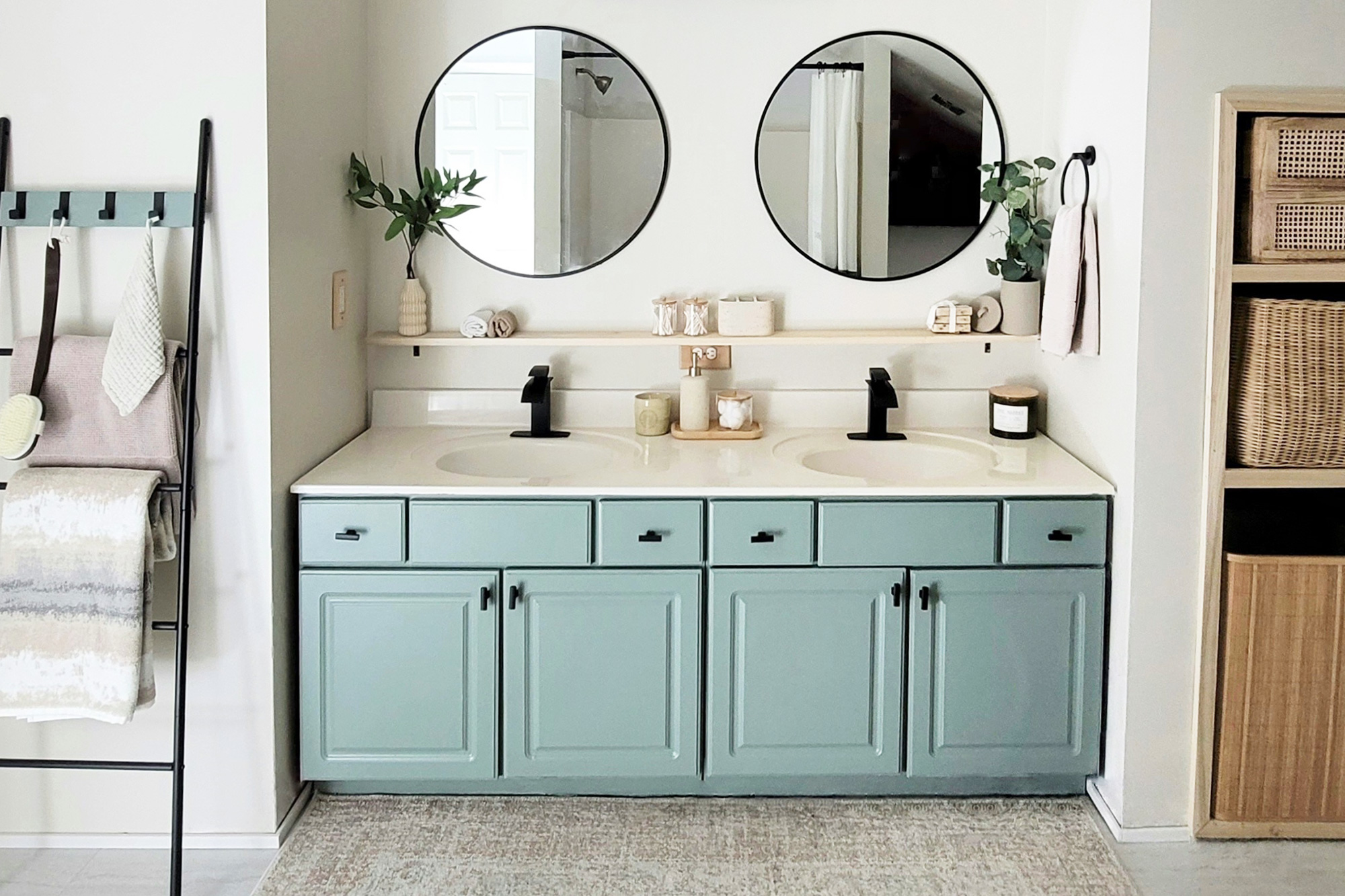
PRO SPOTLIGHT: ANGELA CACACE CREATES A SPACIOUS AND FRESH FEELING BATHROOM
May 19, 2022“How much do you think it will cost?” This is the first question a homeowner asks when I show up to their home for a consultation. This question is always a tricky one and oftentimes the deciding factor that can make or break a dream renovation boils down to material choices. This rings especially true for smaller rooms like bathrooms where the majority of a budget is allocated to what I like to call “big ticket items” like tile that are go-to for their moisture resistance. This can get pricey not only for the material but for labor as well. So if my clients are on a budget, finding creative ways to transform their space while not compromising on the integrity of their renovation is paramount.
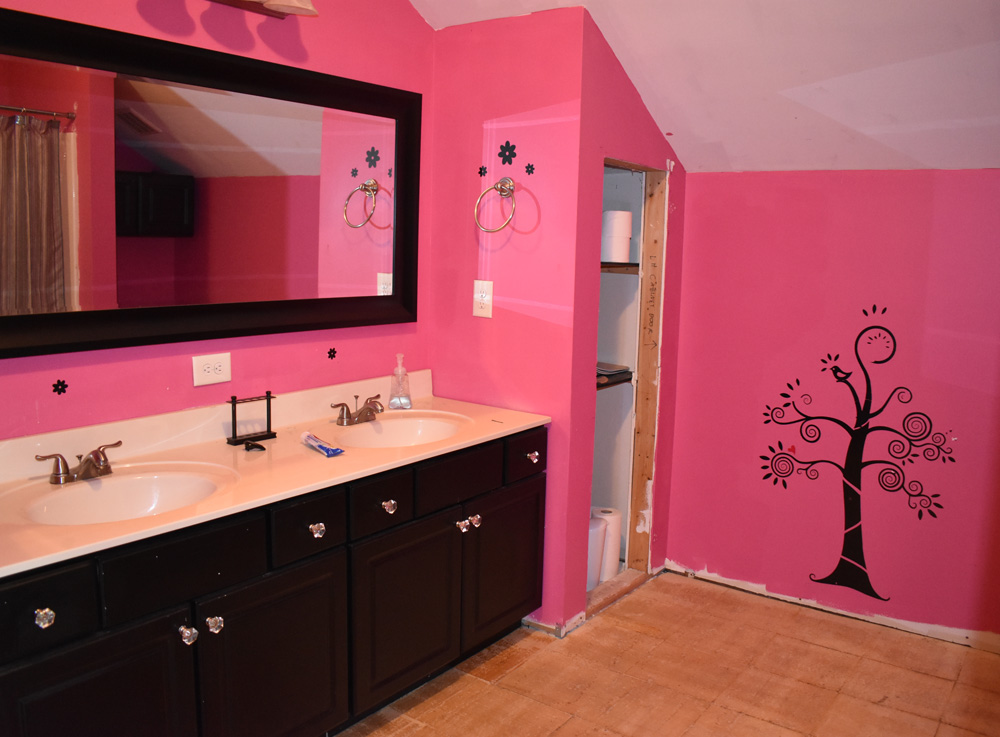
So what do you cover a wall with when you don’t have a hefty budget for floor to ceiling tile? Paint! And although this hot pink bathroom had plenty of it, its previous teenage habitants had vacated and it was way overdue for a more finished and polished look. Using light and airy colors of Magnolia Home by Joanna Gaines® paint to make the bathroom feel fresh and bright is exactly the transformation it needed to feel more spacious. For the walls, Soft Linen provides a calming effect for this new space of refuge. The creamy neutral had a lot to stand up to against the hot pink so a primer was a must.
In order to properly prepare the walls, we used KILZ® Mold and Mildew Resistant Primer; not only for its hot pink covering ability but also, as it states in the name, it protects against the problems caused by moisture and humidity from steamy hot baths and showers and splash zones (if you’ve got little ones at home!). It does this with an EPA registered active ingredient that creates a mold and mildew-resistant film that protects against mold and mildew growth. And if you’ve ever been stuck in a small room with chemicals, you will appreciate its low odor, low VOC formula that makes for a safe and pleasant workspace.
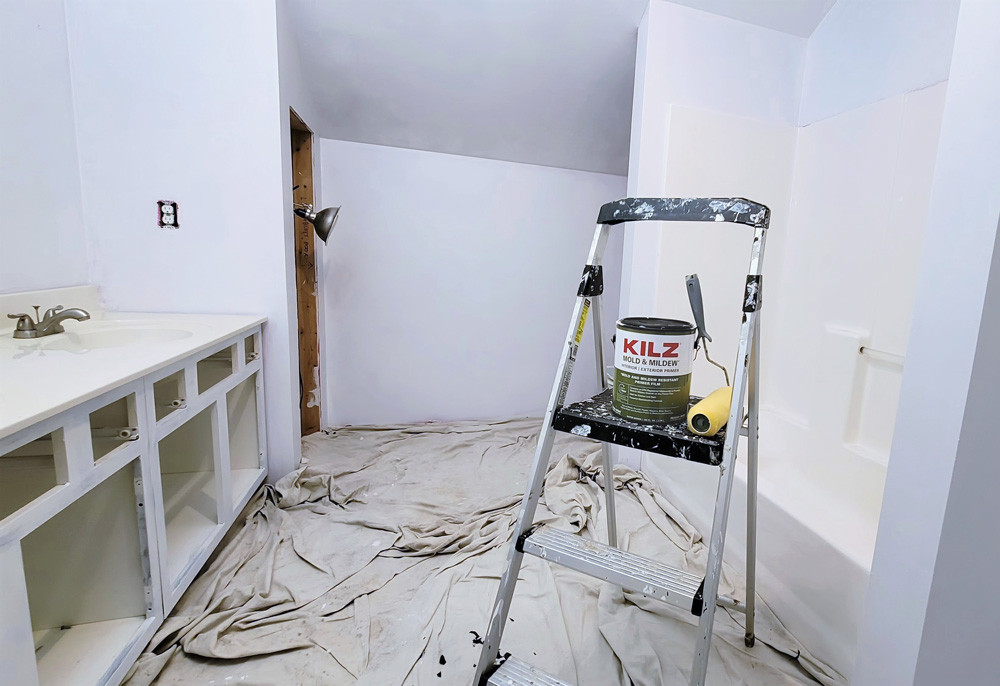
In addition to transforming the wall color, we painted over the existing black vanity with Magnolia Home by Joanna Gaines® Trim, Door & Cabinetry Satin Paint. This water-based acrylic product is specifically designed for surfaces such as kitchen and bathroom cabinets, trim, window frames and doors. Its self-leveling, fast drying formula provides the hardness of a traditional oil-based paint but in an acrylic formula making it ideal for this bathroom vanity transformation. Silverado Sage is the new cabinet color and is a far cry from glossy black. Just like the walls, it needed some serious mold and mildew resistant primer film as well.
With our new selections of Magnolia Home by Joanna Gaines® paint and KILZ® primer ready to go, the bathroom walls and vanity were well on their way. But before we could experience the joy of covering up the hot pink and black palette with a clean slate, prep work had to be done.
For the walls, we began by removing the stickers and screws from old bath accessories. This scraping and pulling did some serious damage so to patch things up, we skim coated and filled in holes with spackle. Once dry, we took a fine grit sand block and smoothed over the surface, removing any excess clumps of paint as well. After sanding, we thoroughly cleaned the room, removing all dust and wiping the walls down with a damp cloth as well as soap and water in sticky areas that needed some additional scrubbing. Once dry, we applied the first coat of primer with a nylon/polyester brush and roller (3/8″ – 3/4″ nap). Although dry to the touch within a half hour, the primer needs a full hour before applying a second coat, which this hot pink definitely required!
To prepare the vanity for the primer, we removed all the doors and drawers and sanded the surface with 120 grit sandpaper to remove the gloss from the black paint to allow for the primer to adhere. After wiping clean and removing dust, once dry, we applied one coat of KILZ® Mold and Mildew Resistant Primer to the face frames and door and drawer faces.
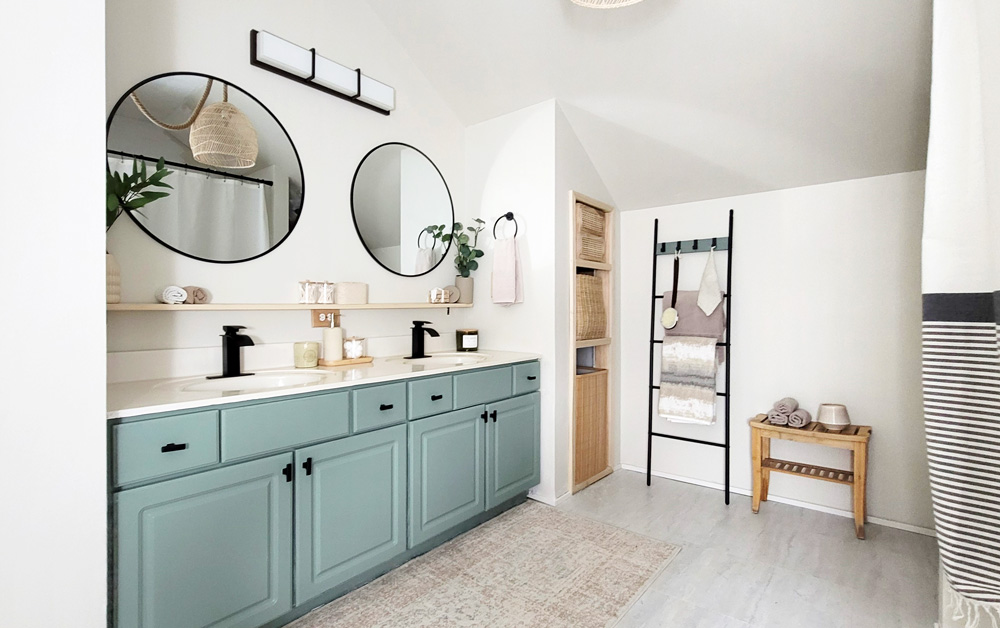
With all the surfaces primed and ready for paint, we were ready for the new, bright and fresh color scheme. For the walls, we used a ½” nap roller to apply Magnolia Home by Joanna Gaines® Interior Paint in Satin finish. For the vanity, we used a high-quality nylon/polyester brush to apply Magnolia Home by Joanna Gaines® Trim Door and Cabinetry Paint in Satin finish. These quality paints were easy to apply and required minimal coats thanks to the blank slate provided by KILZ® primer.
With the addition of some fixture updates and soothing accents throughout the bathroom, the result is truly a transformation from dark, dated and dingy to bright, airy and fresh. And thanks to proper prep and quality products, even without a “big ticket” item like tile, these bathroom walls are well protected and we didn’t have to compromise on design.
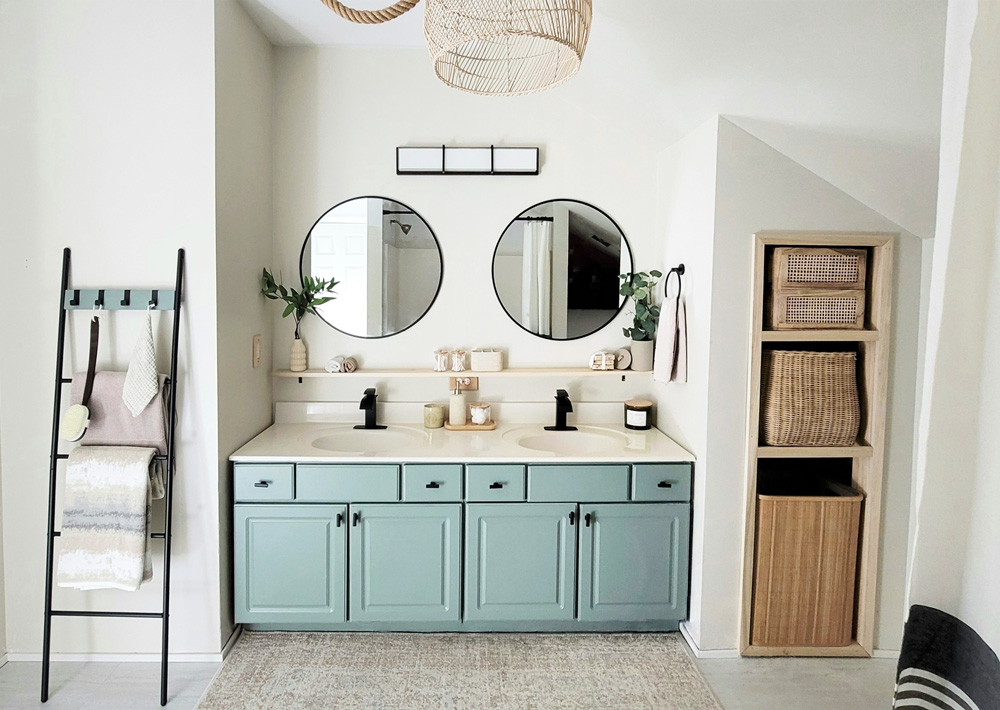
*This is a paid partnership with Angela Cacace.
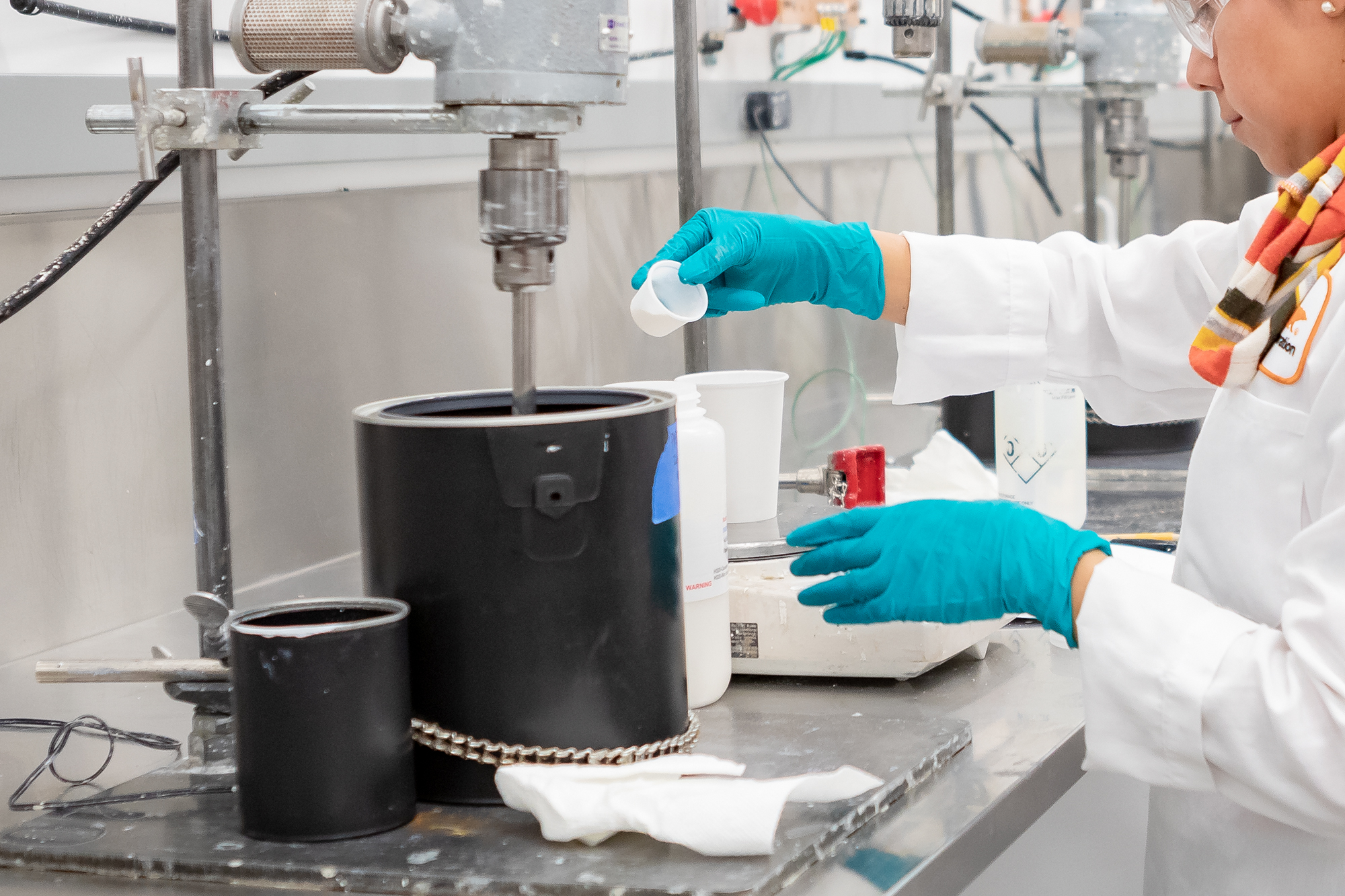
Innovating Today for Tomorrow
April 14, 2022Here on the Perfect Finish, we are going deeper into the creation of our trusted KILZ® primers. There are many people here who work on the KILZ brand that strive to bring the best primer products to market every day to anyone who is interested in getting the job done right. Whether you are a “Do it Yourselfer” or a professional working on a client’s home, the KILZ Research and Development team works hard to innovate today for better products tomorrow.
Why is Research & Development (R & D) important for the KILZ® brand?
At the core, the KILZ brand has a commitment to excellence which includes creating world-class products for consumers. While excellence is difficult to attain, it is something that we not only aspire to but is of our culture and modus operandi. Specifically, the Research & Development team creates and supports KILZ industry-leading architectural coatings products by innovating today for tomorrow’s needs. We focus on the customer by fortifying our position as the industry leader in product quality and performance, using experimentation to find innovative solutions, and adding value to existing products in the realm of performance, longevity, ease of application, and cost.

How does the R&D team continue to add to the success of KILZ products?
KILZ continues to have industry-leading architectural coatings by recruitment, mentoring, and empowerment of the best available people. What separates a good product development program from a great one is the diversity of talent. This means not just hiring the smartest chemists available but also hiring those with diverse skillsets, those who are highly creative and collaborative, are excellent communicators, have top organizational skills, as well as those with project management and mechanical skills, for example.
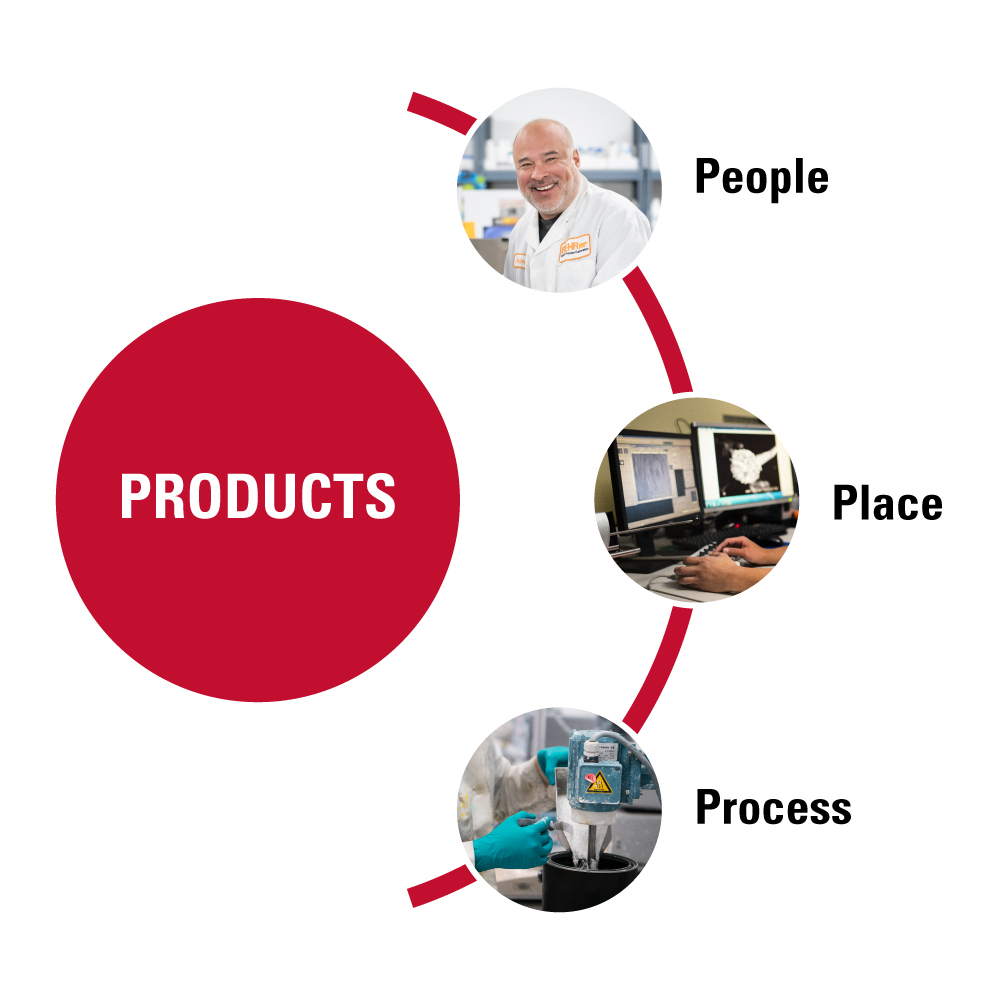
What process goes into creating a new KILZ product? How are our legacy products maintained?
It is important to offer new product solutions and continue to add value to existing products in the realm of performance, longevity, ease of application, and cost management to our KILZ product portfolio as it leads to increased consumer satisfaction and eventual brand loyalty. Our vision is to be our customers’ first choice for all their architectural coatings needs.
As such, KILZ uses a process whereby new products and ideas are created and vetted. This type of process is well defined, cross-functional, and time-bound. Throughout the process, there are several check-ins making sure we are meeting not only our internal but external customer needs.
R&D plays a role throughout the entire process giving input as necessary, whether it is searching for technical gaps, giving input on how complex the project will be and how familiar we are with the technology needed, and evaluating resource availability. The R&D team is also responsible for collaborating with different departments to make sure the prototypes meet the project scope, the product claims and the consumer’s expectations.

Each KILZ product, whether it is new to the market or those that are product legacies, undergo routine chemical and physical paint property testing which helps predict, verify, and determine the coatings performance and compliance. We use the most up-to-date industry-standard test methods including those from ASTM (American Society for Testing and Materials), MPI (Master Painters Institute), ANSI (American National Standard Institute), JIS (Japan Industrial Standards), and ISO (International Standardization Organization). We monitor customer level feedback, application, perform exposure series, benchmark our competition, and submit our products for third party testing so we understand where our products stand in the market but also to help us improve the consumer’s experience making us one of the top trusted paint brands in the US (United States).
Always remember to refer to our website kilz.com or product back labels for additional information on which primer is right for your project and detailed instructions on how to apply our products. Check out our Coverage Calculator to understand your estimated paint needs for your upcoming project.
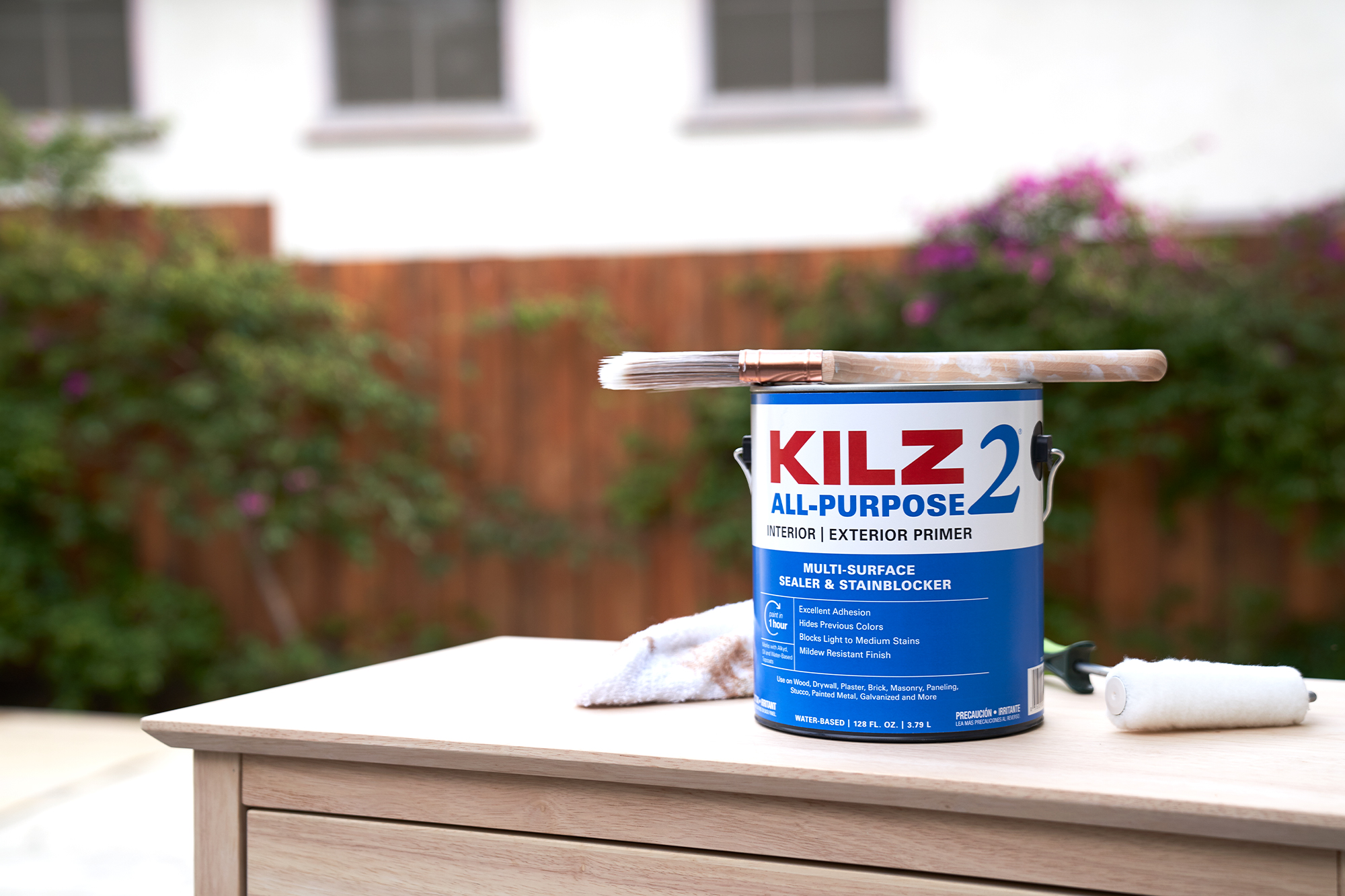
KILZ® Products, Coatings, and the Environment
April 12, 2022 The KILZ brand takes pride and deliberation when it comes to its paints and primers and the environment. Greg Williams, our Director of Product Marketing, shares how the KILZ team keeps the environment in mind when developing products for our business. “I’m passionate about protecting the environment as we only have one world, for us and future generations to come.,” Greg expresses, “It is our responsibility to protect our ecosystems, be good stewards of natural resources, and live in harmony with the world around us. We should all strive to minimize our personal impact on the environment.”
The KILZ brand takes pride and deliberation when it comes to its paints and primers and the environment. Greg Williams, our Director of Product Marketing, shares how the KILZ team keeps the environment in mind when developing products for our business. “I’m passionate about protecting the environment as we only have one world, for us and future generations to come.,” Greg expresses, “It is our responsibility to protect our ecosystems, be good stewards of natural resources, and live in harmony with the world around us. We should all strive to minimize our personal impact on the environment.”
Ways you can paint with KILZ® products while helping you minimize your environmental impact.
1. When completing a painting project, choosing a high-quality coating such as a KILZ primer or paint will extend the lifespan of your project and reduce the frequency of re-painting.
2. KILZ products are designed with quality raw materials to provide optimal performance and service life. Also, they are manufactured in facilities where over 95% of liquid byproducts are repurposed and in 2021, 83% of refuse was recycled.
3. Proper disposal of your paint products is a crucial step in the process to reducing your environmental impact. For more information on disposal, see disposal section below and KILZ.com.
Why is it important to choose a high-quality product for my project?
• Primer and paint help provide protection for the substrates they are applied to, which can increase their lifetime. Achieving your result with fewer coats and reducing your need to re-paint as frequently will help minimize your overall environmental impact.
• Whether it be drywall or a more challenging substrate like bare metal, weathered wood, or a chalky paint surface, primer and paint can help to protect and extend their service life.
• KILZ primers have exceptional stain blocking properties and help achieve full hide by locking the stain molecules into the film. This results in fewer coats, material, and time required to complete the job.
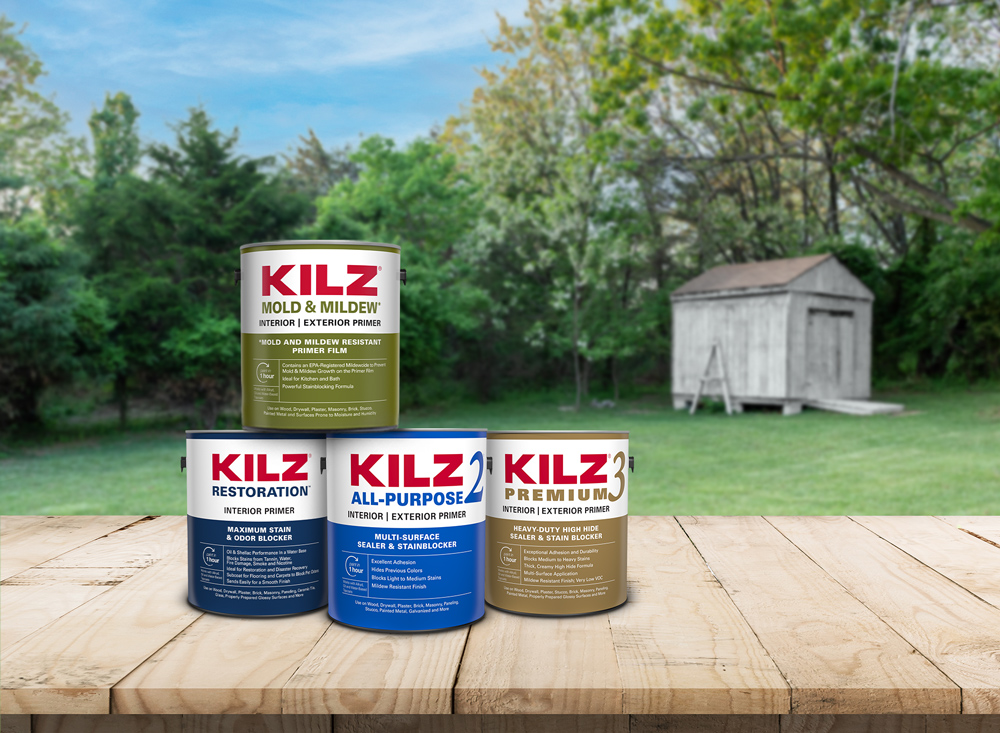
What strides has KILZ made to develop products while keeping the environment in mind?
• KILZ has focused on developing high performing water-based products, with lower VOCs (volatile organic compounds), while maintaining performance attributes comparable to their oil-based counterparts. (Check out our post about Oil vs. Water based products here). All KILZ products are designed to meet national, state, and local VOC regulations, without compromising performance.
• Many of our products are GREENGUARD® Gold certified, including KILZ® PVA, KILZ 2®, KILZ® 3, KILZ® KITCHEN & BATH, KILZ KLEAR®, and KILZ RESTORATION® primers. GREENGUARD Gold certification confirms the certified products are low VOC and minimize impact on indoor air pollution levels.
• In addition to the liquid inside the can, we now use an all-plastic can which is made of recycled plastic and is 100% recyclable at recycling centers.
• We recycle and reuse many materials and byproducts during the manufacturing process. For example, in 2021 we recycled over 5.5 million pounds of plastic, metal, wood, paper and cardboard.
• We make it easy to determine the amount of product necessary for your project. It is important to use only the material that you need to minimize waste. We provide estimated coverage rates as well as a coverage calculator tool so you can purchase the appropriate quantities for your jobs.
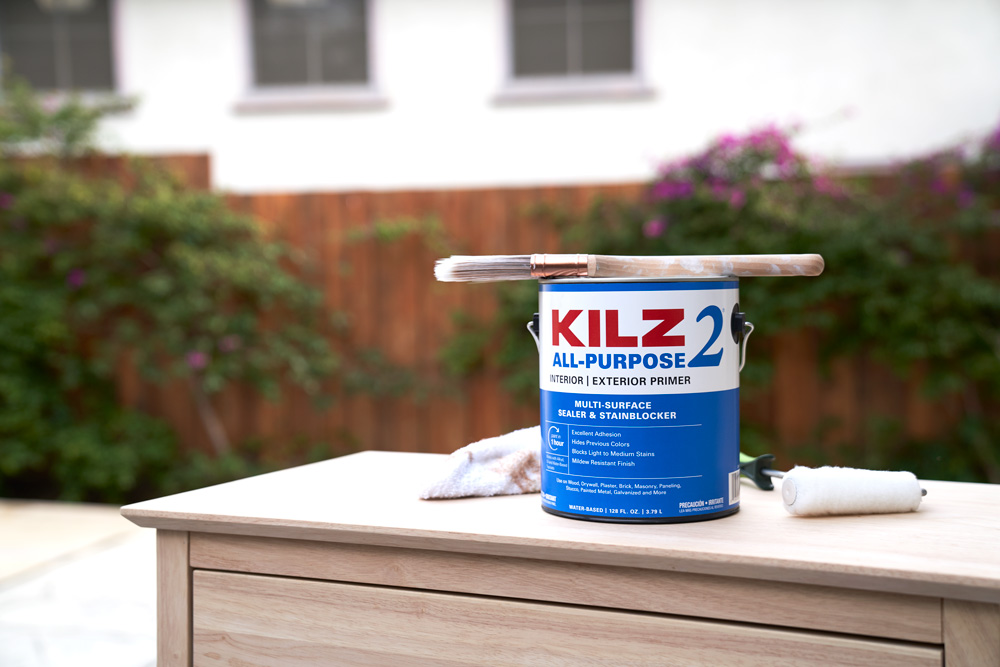
What is the best way to dispose of cans and extra product?
• We would advise researching local paint disposal regulations. Many areas have local household hazardous waste drop off sites that will collect old and unwanted paint. In addition, more states are now joining PaintCare, which puts a focus on recycling paint, further reducing the impact of unused paint.
• Local charities may also be willing to accept unused paint in good condition as a donation.
Always remember to refer to our website kilz.com or product back labels for additional information on which primer is right for your project and detailed instructions on how safety and application of our products. Check out our Coverage Calculator to understand your estimated paint needs for your upcoming project.
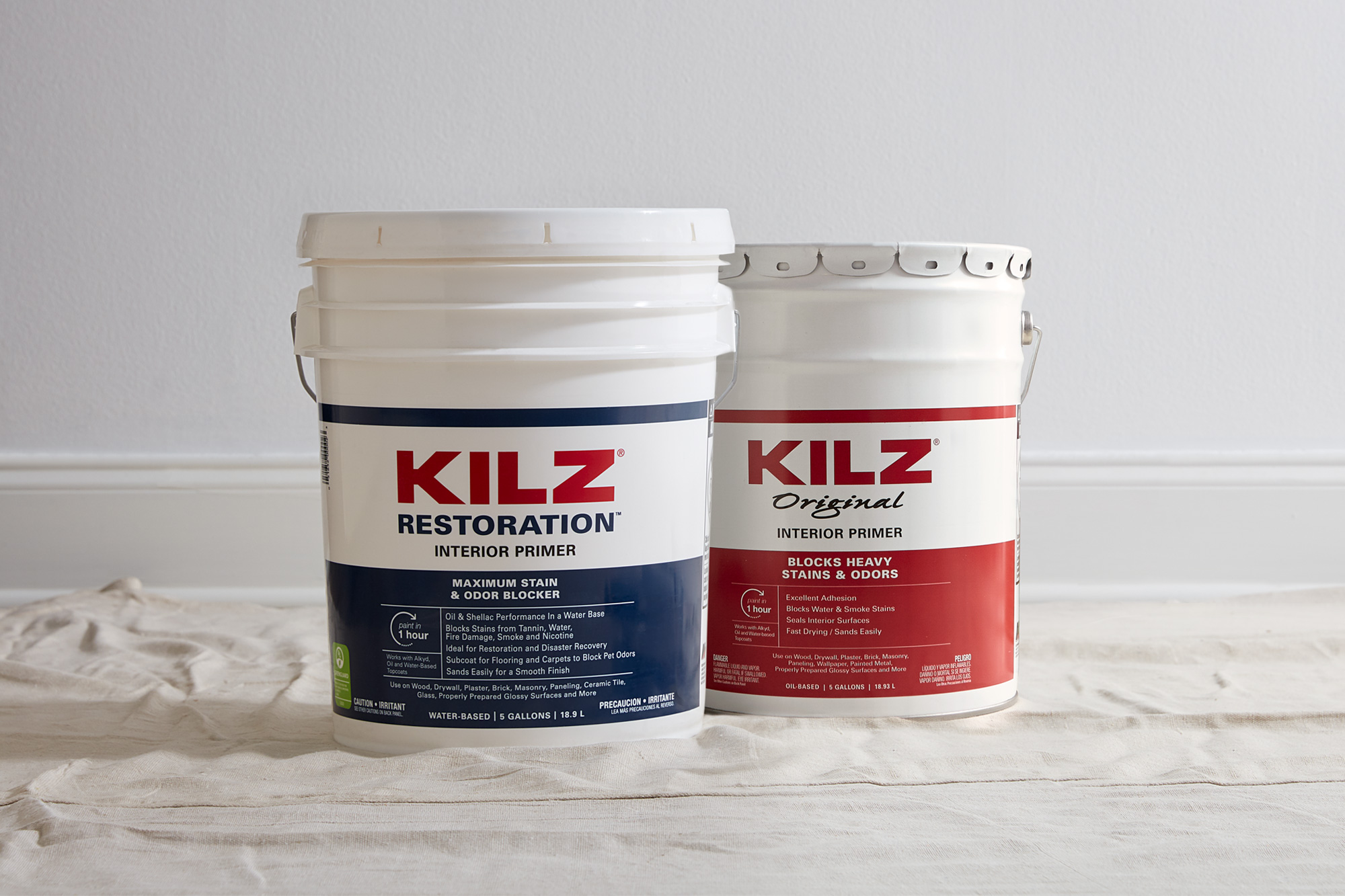
Restoration vs. Original – What’s the Difference?
February 25, 2022 For the last 7 years, John Golamco has led the primer category at KILZ®. He is the Product Manager representing this category and has over 25 years of collective experience in sales and marketing. He lives in Southern California and enjoys traveling and cooking when he isn’t priming various surfaces!
For the last 7 years, John Golamco has led the primer category at KILZ®. He is the Product Manager representing this category and has over 25 years of collective experience in sales and marketing. He lives in Southern California and enjoys traveling and cooking when he isn’t priming various surfaces!
Why are we comparing KILZ® Original and KILZ Restoration® Primers?
When our customers have a project that involves severe stains and/or persistent unwanted odors, they turn to KILZ primers. Two products that help solve these problems are KILZ Restoration water-based primer and KILZ Original oil-based primer. KILZ Restoration is an innovative water-based primer which provides similar performance in stain and odor blocking as the long-established oil-based KILZ Original primer. Shellac and oil-based are traditionally better known to block severe stains especially water-soluble stains.
What are the differences between KILZ Original & Restoration Primers?
KILZ Original is an oil-based primer and stain blocker which can block/seal severe stains and odors but has higher volatile organic compounds (VOC’s) which are organic chemical compounds that vaporize and enter the atmosphere. It also has a stronger solvent odor and requires mineral spirits or paint thinner to clean-up. KILZ Restoration is a water-based primer which also blocks severe stains and odors, however, has lower VOC’s which meets all national regulations. It is also a low odor primer and has easy clean-up with soap and water.
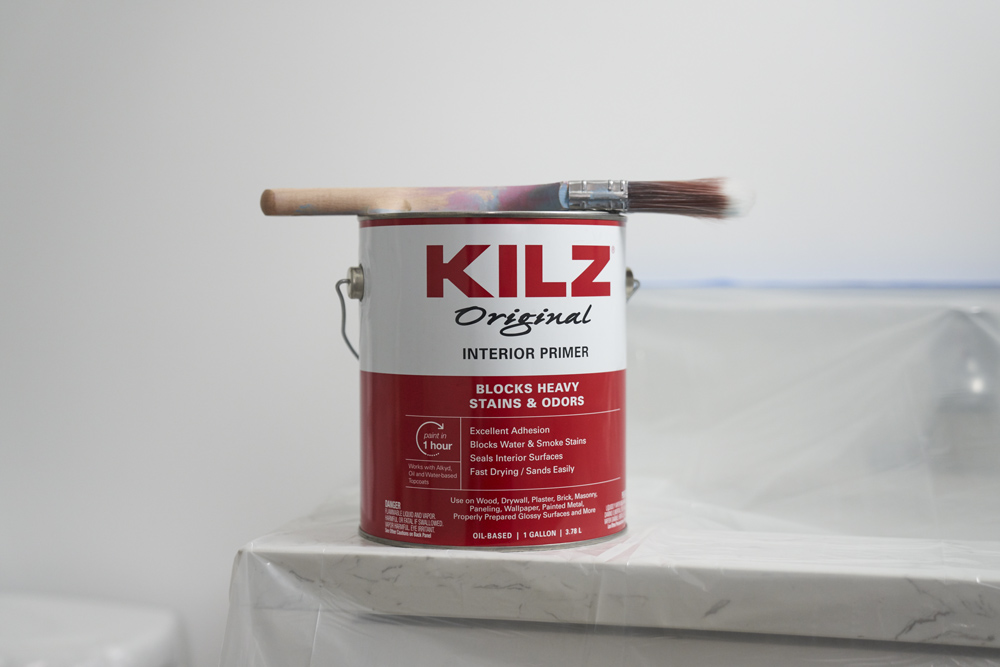
What is an oil-based primer? What are the benefits?
Oil-based primers are better at blocking or sealing stains, especially water-soluble stains. They’re also superior at blocking tannin. Oil-based primers have natural (i.e. linseed oil) and synthetic (i.e. alkyd oil) variants as their base technology. Alkyds have become popular in recent decades due to more easily sourced raw materials, lower cost and durability of the coating film.
TOP BENEFITS
1. It dries to a hard finish, making it durable against wear and weather.
2. Feels thick to apply and feels like it adheres well upon application which makes for an outstanding application experience.
3. Penetrates wood fibers well, making it ideal in sealing and protecting the wood.
4. Slower dry time compared to water-based which has some advantage in giving more open time to apply and for touch-ups.
KILZ Original interior primer for example, is a legacy product trusted by pro painters for 50 years! It delivers excellent stain blocking, odor blocking, adhesion performance, durability and is a fast-drying oil so pros can get more done in less time. KILZ Original line of oil-based primers use top quality modified alkyd resins as the base technology of their primer formulas.
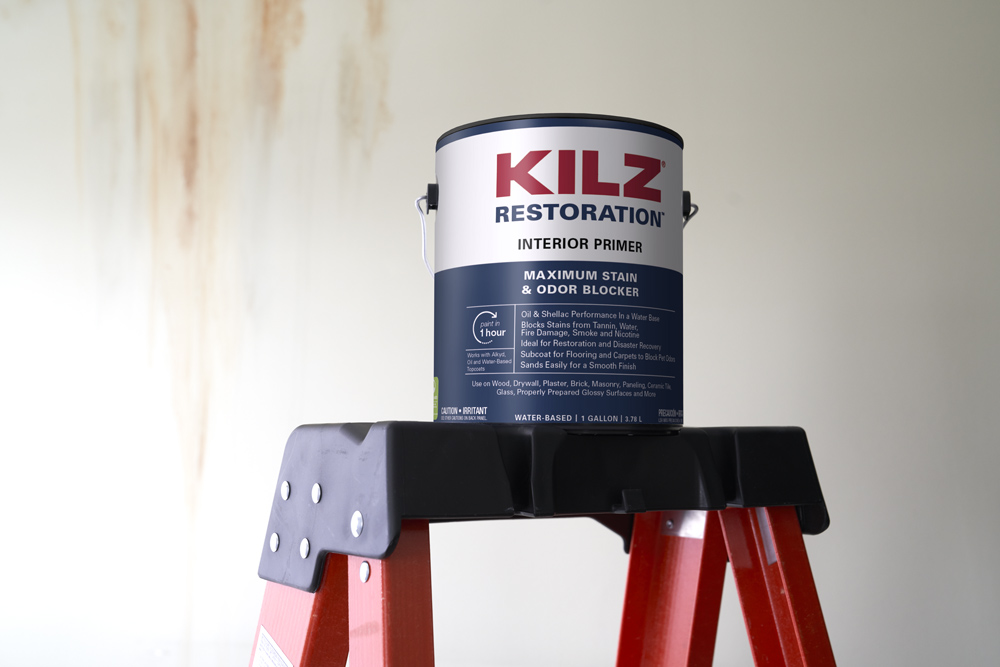
What is a water-based primer? What are the benefits?
Water-based primers, also known as “latex” primers, are easier to clean (using soap and water), dry fast and have low VOC’s, making them healthier to use for you and the environment. In terms of their formulations, water-based primers, like water-based paints, use water as the solvent. Several other ingredients such as binders, pigments, fillers, and additives are then mixed in to create the final product.
TOP BENEFITS
1. Not combustible or flammable.
2. Low in odor making it ideal for use in interior spaces while oil-based needs very good ventilation.
3. The advancements in coatings technology have allowed water-based primers to dramatically improve and are beginning to perform on par with oil-based primers in terms of adhesion, stain blocking, and even odor blocking; and they have a faster dry time which saves time and money.
KILZ 2® ALL-PURPOSE, which is KILZ best-selling primer, is an acrylic polymer since it uses an acrylic plastic resin as its base ingredient – this is what makes the primer stick well to the surface and gives topcoat paint a sound, uniform surface to stick to – making it look better and last longer. KILZ RESTORATION is a new innovation in water-based primer technology which gives this product the performance of an oil-based (in severe stain blocking and odor blocking) but with the low VOC’s, low odor, easy clean-up and faster drying time that water-based provides. It’s the “best of both worlds”!
When would you choose to use an oil-based primer over a water-based primer? And vice versa?
TEAM OIL-BASED
• Choose an oil-based primer if priming over a previous oil-based paint and/or priming on fresh wood.
• Oil-based will seal the wood better and block any tannin stains that might bleed out.
• Oil-based is also ideal if blocking smoke and water stains as well as unwanted odors.
TEAM WATER-BASED
• Choose water-based if priming indoors where ventilation may be poor and in spaces sensitive to strong odors.
• Ideal choice when projects require a lower VOC level product, there is a flammability concern, and/or there is preference for clean-up without the use of harsh chemicals.
• State and local regulations might make oil-based products limited in availability or access. In such cases, water-based is a great choice.
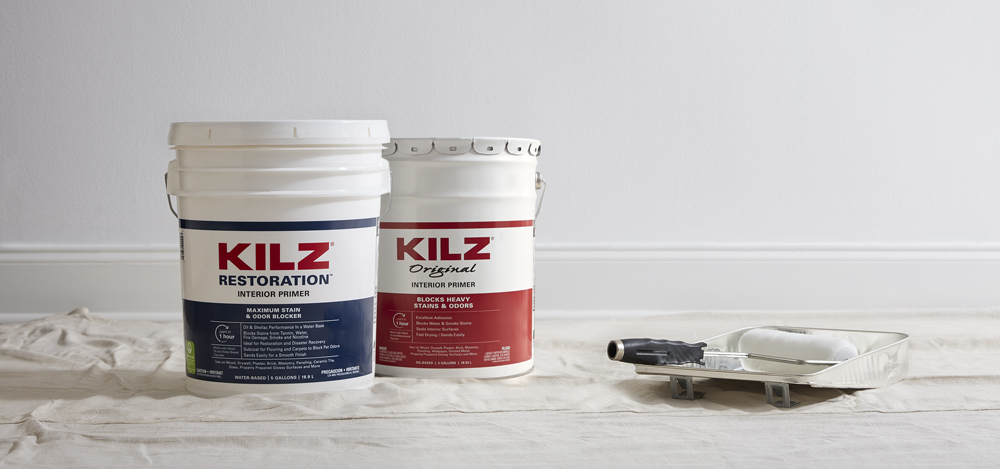
What are the best use cases for Oil-based? For Water-based? Project examples?
Oil-Based: priming over water stains on ceiling tiles or priming over bare wood especially redwood varieties that bleed tannin/sealing wood knots would be some specific examples of best use cases for oil-based. Also ideal for blocking/sealing severe stains especially water-soluble stains that might be “activated” and bleed through if a water-based primer is used. Oil-based primers are also durable since they dry to a harder finish. KILZ Original Interior/Exterior primer for example is an excellent choice for exterior application due to its weather resistance, especially on wood surfaces.
Water-Based: priming indoor walls and cabinets in a space with limited ventilation or a project where low VOC emissions are a requirement. In both cases, do not apply too many coats of the primer. Even if the primer does not look like a finished coat, it is adequate to do the job of sealing the surface, blocking the stain (if any) and laying a good foundation coat to help the topcoat adhere (stick). It’s the paint’s job to completely cover everything and deliver the expected final color. The primer will help the paint look its best. A paint coatings calculator is available on https://www.kilz.com/calculator.
Always remember to refer to our website kilz.com or product back labels for additional information on which primer is right for your project and detailed instructions on how to apply our products.
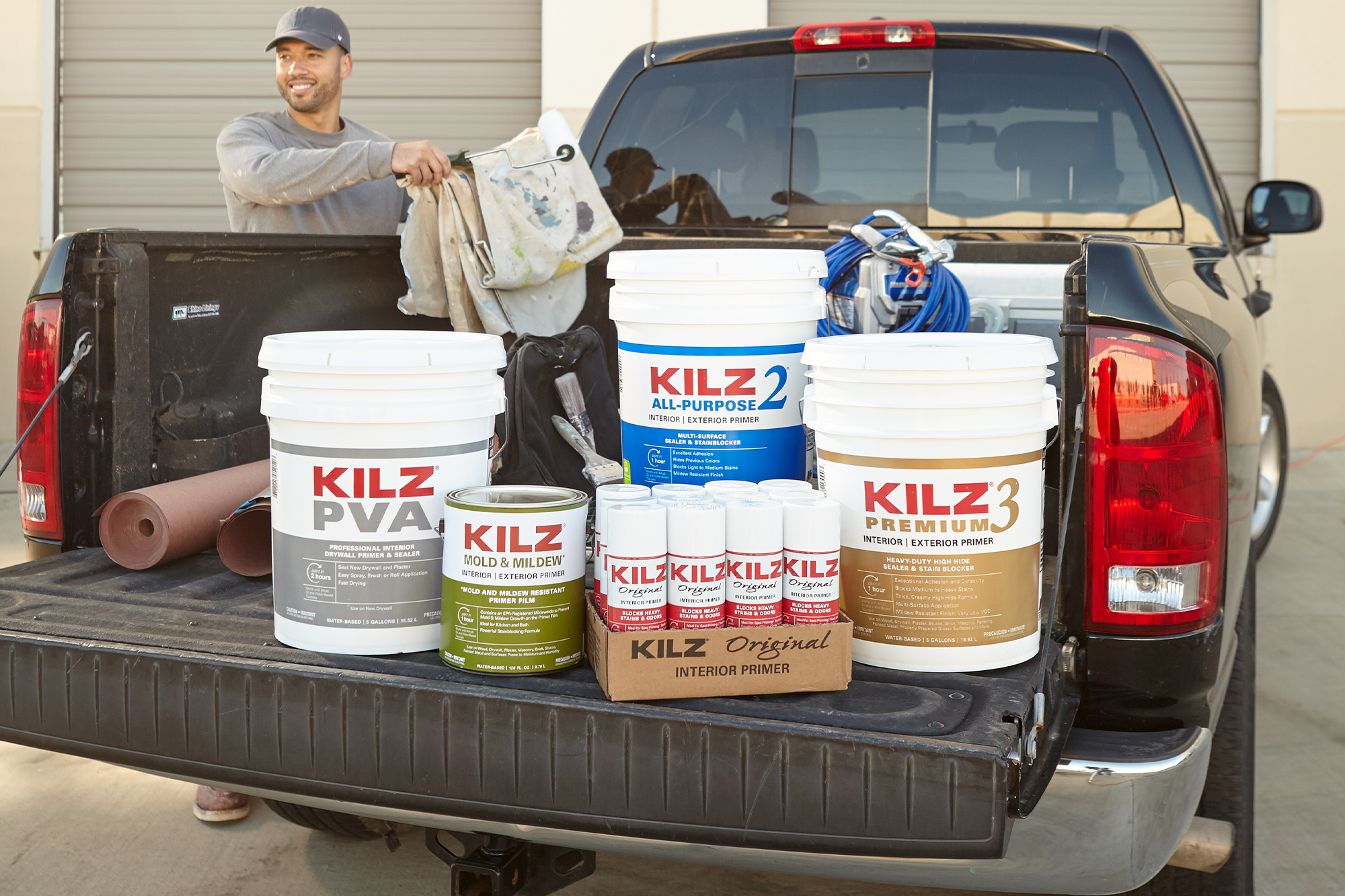
Ask the Pro: Must-haves for 2022
January 28, 2022 New Year, new inspirations, and new projects! What better way to kick off the year than to share the “must-haves” for any project in 2022. We asked one of the KILZ experts, Paul Dambroso. Paul is the Vice President of Marketing at KILZ and shares over 20 years of experience. Here on the Perfect Finish, we are going to cover the top KILZ products that any professional may need to kick off a project.
New Year, new inspirations, and new projects! What better way to kick off the year than to share the “must-haves” for any project in 2022. We asked one of the KILZ experts, Paul Dambroso. Paul is the Vice President of Marketing at KILZ and shares over 20 years of experience. Here on the Perfect Finish, we are going to cover the top KILZ products that any professional may need to kick off a project.
Why is it important to use Primer for any project?
- Seal porous surfaces before painting to achieve a uniform finish in fewer coats of paint
- Block stains from bleeding through your topcoat finish (water stains, tannin, smoke)
- Improve adhesion between the surface and the topcoat paint (adhesion promoter)
- “Specialty primers” help solve a variety of problems in specific situations from preventing mold and mildew before painting, transparent finish primers for same color recoats, alkali-resistant primers for powdery surfaces, concrete, cement, and unpainted plaster, metal primers, and more.
What are the top 5 KILZ Primers you need to tackle any job?
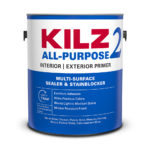
- KILZ 2® ALL-PURPOSE Primer (Previously KILZ 2 Latex) is a fast drying, water-based, multi-surface primer-sealer-stain blocker with excellent adhesion, mildew resistance, sealing properties and very mild odor. KILZ 2 ALL-PURPOSE Primer blocks medium stains including minor water stains, rust, grease, ink, pencil and felt marker. Enhanced hiding makes it ideal for changing colors and helps lessen the number of coats of paint required.
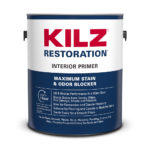
- KILZ RESTORATION™ Primer is a new generation water-based primer, sealer and stain blocker offering performance of traditional oil and shellac-based primers. It tackles tough stains including heavy water damage, rust, smoke, nicotine, grease, tannin, ink, pencil, felt marker, pet stains and more.
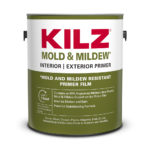
- KILZ® MOLD & MILDEW Primer is a water-based primer-sealer-stain blocker that is specially designed for residential surfaces in high humidity, moisture, and temperature environments such as kitchens, bathrooms, powder rooms and laundry rooms. It offers excellent adhesion to both interior and exterior surfaces and provides a sound anchor for paints. The EPA (Environmental Protection Agency) registered active ingredient creates a mold and mildew-resistant film that protects the primer film from mold and mildew growth.
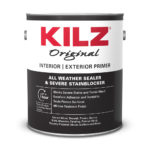
4. KILZ Original Oil-Based Interior/ Exterior Primer
- KILZ® ORIGINAL has been a trusted brand for over 40 years! This interior and exterior primer is specially formulated to be a sound undercoat for paint and will help enhance the topcoat’s performance. It has excellent adhesion to both interior and exterior surfaces including masonry, metal, and excellent penetration for bare wood.
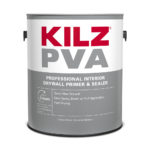
- KILZ® PVA DRYWALL PRIMER is designed for use on new drywall. It is a fast drying, interior water-based primer formulated to prime and seal new, uncoated drywall and reduce the number of topcoats required to achieve a uniform, professional quality finish.
What are some tips and tricks while using Kilz primer?
- Check out KILZ Coverage Calculator to determine how much paint is needed to start a project. Typically, a gallon of primer will cover up to 250-400 square feet of surface that depends on a variety of factors. Two coats are usually required to have bright or deep colors or stains that could bleed through the topcoat. If priming over light or white previously painted surfaces, one coat may be sufficient.
- Tint the primer with a small amount of colorant (paint) of the topcoat. This will enhance the accuracy of the topcoat’s true color.
- Lightly sand the surface before applying primer especially if there is a gloss or sheen on the surface. This will help the primer adhere better and result in a longer-lasting paint finish.
- Although today’s advanced chemistry allows compatibility between oil-based and water-based primers and topcoats, it is still best practice to keep the combinations of “oil-based over oil-based” and “water-based over water-based” to ensure optimal results.
- Check out the KILZ blog post on the misconceptions about primer with one of our product experts here.
Always remember to refer to our website kilz.com or product back labels for additional information on which primer is right for your project and detailed instructions on how to apply our products.
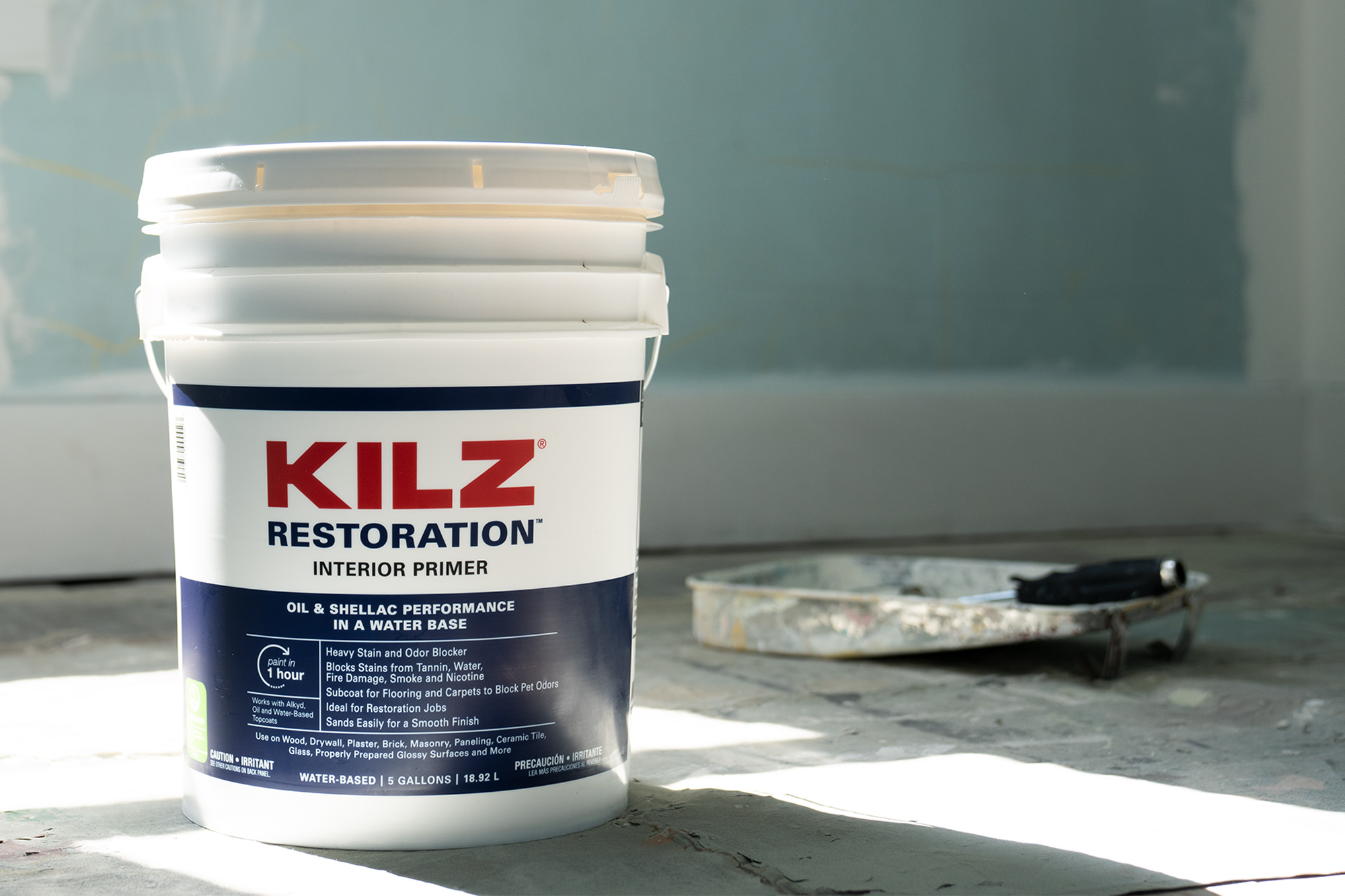
Ask the Pro: KILZ Restoration®
October 27, 2021
Here on The Perfect Finish, we have shared the importance of Primer in a variety of room transformation projects, from changing paint colors to painting kitchen cabinets. In this post, we are taking the conversation to a larger scale, looking at whole home renovations from a Pro’s perspective. We were excited to chat with Dustin Almquist, a contractor in Pennsylvania with experience in both real estate and property investment.
Dustin shares how KILZ Restoration® Interior Primer is vital to his whole home renovation jobs and why he believes a transformation of a whole house can change the perspective of the entire neighborhood. Read on to learn how he gets the job done right every time.
Tell us about your recent restoration job using KILZ Restoration Primer.
This project was a full house renovation. The last owners had the home for decades, and regular maintenance wasn’t done. It needed new electricity, plumbing, kitchen, bathroom, roof, windows, flooring, and of course primer and paint. The walls were old plaster that had some major cracking. After making extensive repairs, it was important to prep the walls for paint. Since many of the walls had old oil-based paint or paneling, it was important to use a primer that I could trust.
Why did you choose KILZ Restoration® Primer for this project?
This property is used as a rental. I wanted to ensure that I am getting a long-lasting, durable wall coating. When it is time for a topcoat, I need to know that I won’t have adhesion issues. KILZ Restoration® Primer gave me the security that a topcoat will apply evenly and have great adhesion. Additionally, the coverage of the old surface was going to need a serious primer. Using a lesser primer would have left me with exposed stains and old wall color bleed through.
• KILZ Restoration® Interior Primer is a water-based primer, sealer, and stain blocker offering the performance of traditional oil and shellac-based primers. It tackles tough stains including heavy water damage, rust, smoke, nicotine, grease, tannin, ink, pencil, felt marker, pet stains, and more.
What benefits did it bring to the job that another primer might not?
KILZ’s reputation of quality products is second to none and KILZ Restoration® Primer is the real deal. The old oil-based paint on the walls had some small cracks and splitting, but it was no match for the Restoration Primer. It is quite thick, so it filled those problem areas, yet still dried evenly and smoothly.
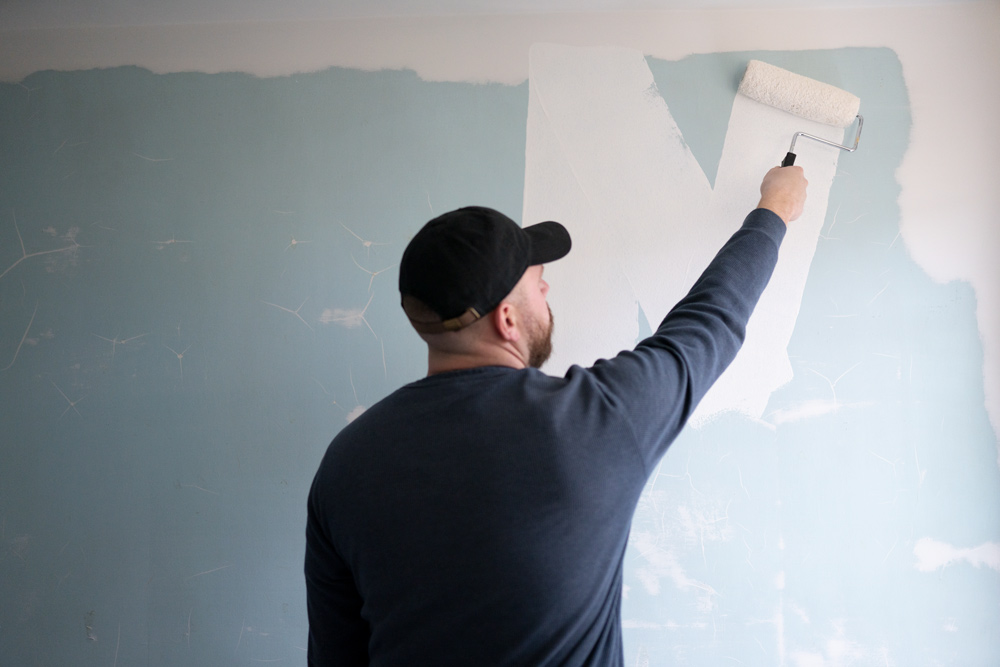
Where did you use KILZ Restoration® Primer at the project site?
The whole home! The house contained three bedrooms, a bathroom, kitchen, dining room, and living room.
Have there been any other projects when KILZ came to the rescue?
I am currently working on another rental property in the same town. The entire interior needs to be painted. Again, since this house will be used as a rental, I want to trust that the work I do today can last for years to come. I have primed the entire house using an array of KILZ primers.
Would you recommend using KILZ primers for any project?
I have yet to be disappointed in any use of KILZ primers. Each application has provided me with the results I need.
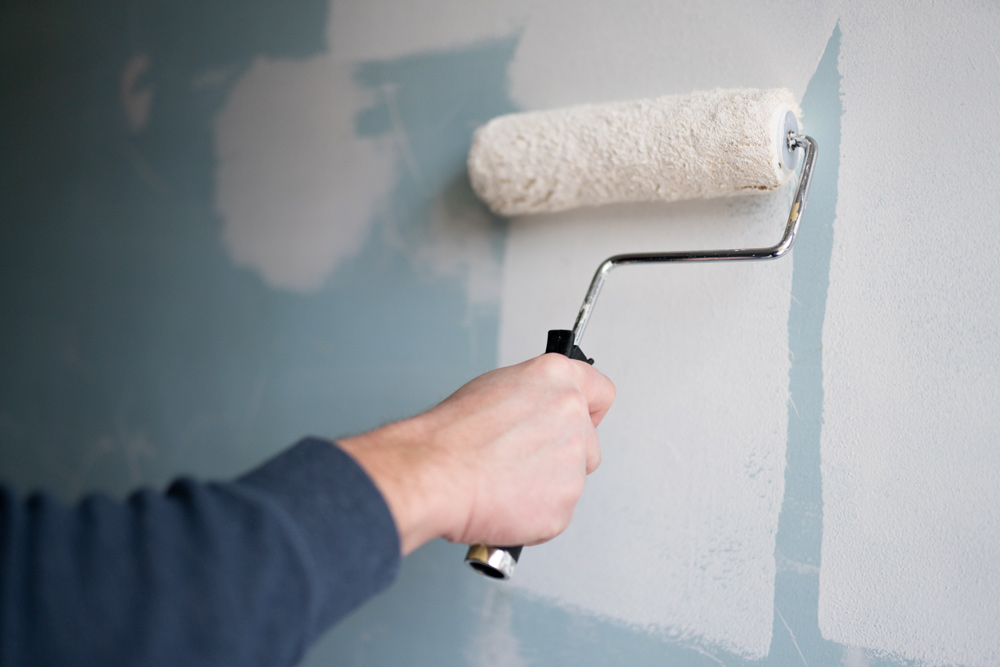
Do you have any other tips for a home restoration project?
Make sure to plan! When you get into restoration, time is money. It is so tempting to take shortcuts to save yourself time. Many people don’t think about the amount of time in the future they are costing themselves when taking those shortcuts. Take the time to do the work correctly the first time. It will pay dividends tomorrow!
What additional tools would you need to get the job done?
Paint sprayers, pans, rollers, roller covers, brushes, scrapers, extension poles, drop clothes, painters’ tape, buckets, ladders, rags, caulks/sealants, brush cleaner, paint thinner, stir sticks. You name it! It seems like you always run out of something right when you need it.
Always remember to refer to our website kilz.com or product back labels for additional information on which primer is right for your project and detailed instructions on how to apply our products.
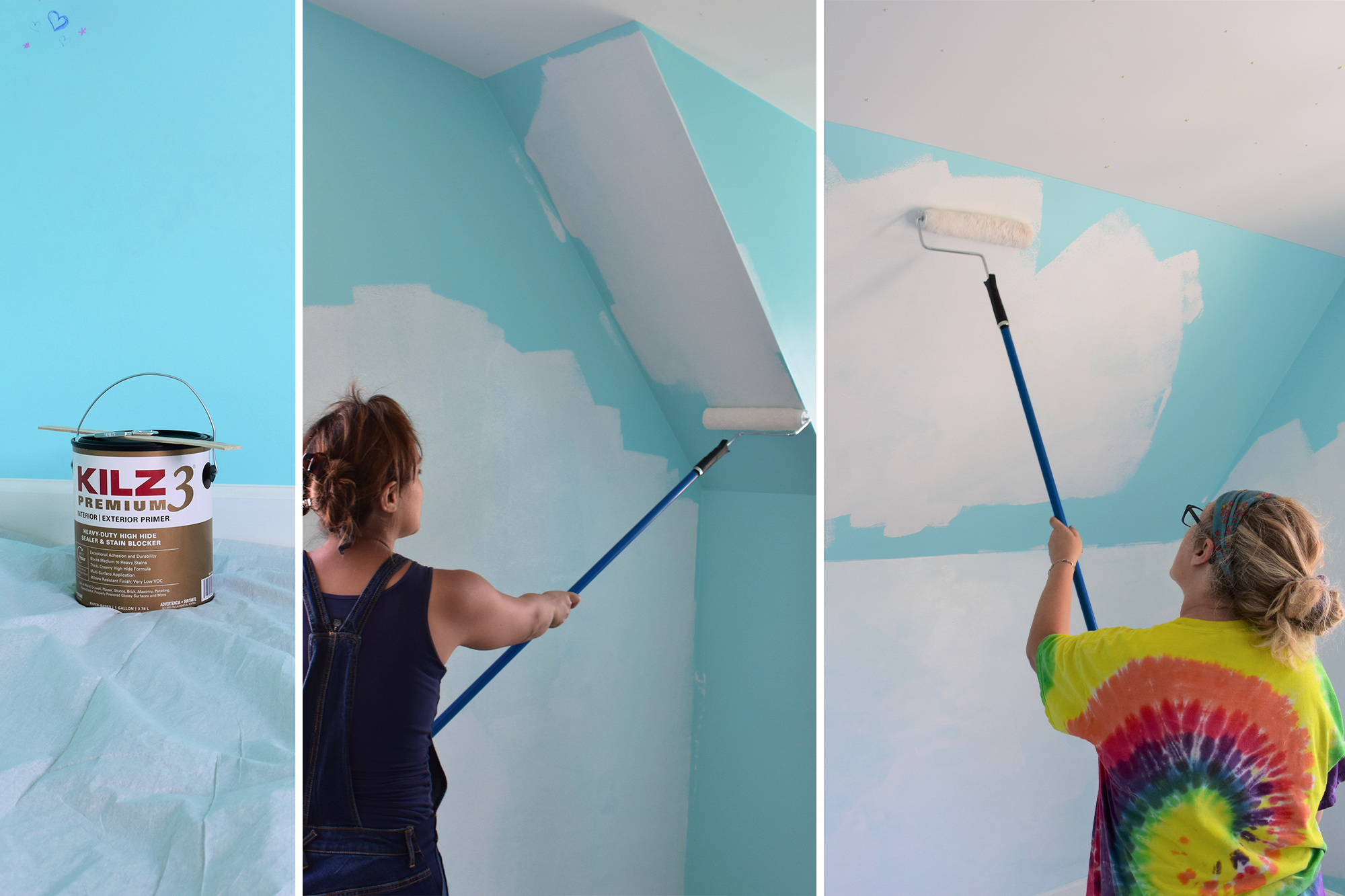
A Quick Color Change: Angela Cacace
October 18, 2021The bedroom. It’s the first space on this earth that an individual can claim as their own. There is that pivotal moment in every person’s life when they find themselves covering yesteryears’ painted walls with any cool poster or sticker they can find. And what’s left? A hodgepodge of a room that doesn’t fully reflect their newfound identity in the world as they leave their formative years and enter their tween years. With so much going on in the world today, I can only imagine what todays’ kids are having to cope with as they have navigated through this last year and a half. So as a designer and contractor for a remodeling company, I can’t think of a more deserving clientele in need of a space of refuge to call their own.
After a year of a pandemic that kept her out of school, my tenacious client, Saegan, was ready to tackle a fresh, new beginning. Excited at the prospect of finally being able to throw sleepover parties and hang out with her best girlfriends, she needed a major bedroom update. This room was going to be epic. A full reflection of the young woman she is growing up to be, I was so excited to help her find her design voice and style.
So where to begin? Few projects provide transformation in a bedroom but paramount to the small list is paint. A quick color change is exactly what this makeover so desperately needed to literally set the tone of the room.
Quite on-trend, Saegan wanted a two-tone wall, because why settle for one color when you can have two?! This technique is achieved by painting the area on the lower half of the wall (typically below standard chair rail height which is around 32”+) a different color than the upper half of the wall. This painting technique was not only beneficial in decision-making for a dynamic tween, but it was also a great choice for her dormer-walled room. Dormers are an architectural detail commonly found in the cape-cod style of home that Saegan’s family lives in. Along with a fun window nook, these types of rooms in a home boast steeply angled walls that follow the roof’s pitch. So in addition to providing visual interest, this two-tone technique worked with the shadows and angles of the walls rather than against them.
Sagean knew she wanted to paint colors that were lighter, brighter, and full of girl-power. So, after a quick field trip to the local paint store, Saegan decided on her two colors. She chose “In Bloom” and “Cement Pots” from the Magnolia Home by Joanna Gaines® Paint Collection.
Bringing your paint swatches into the space and purchasing a sample to test it out on your walls is a must. Lighting differs from house to house and room to room, so it is crucial in ensuring that you have chosen the right color. However, in Saegan’s room, this step was not so simple because there was no way the reflection of her brightly colored room was going to allow us to see the true color in her space. With bright teal paint on the existing walls and stickers and doodles abound, good prep was a must to ensure a favorable outcome.
With proper prep in mind, we purchased KILZ 3® PREMIUM primer. This is the ideal primer when you are going from a darker to lighter paint color. And in Saegan’s case, we wanted to make sure that her new softer, more mature colors showed true without having to apply multiple coats to cover up the intense teal paint. Also, this primer’s thicker high hiding formula hides surface imperfections like marker artwork! Now, having grown out of wall scribbles and sticky hands, this very low VOC, water-based primer-sealer-stain blocker provided the clean slate we needed for a fresh start.
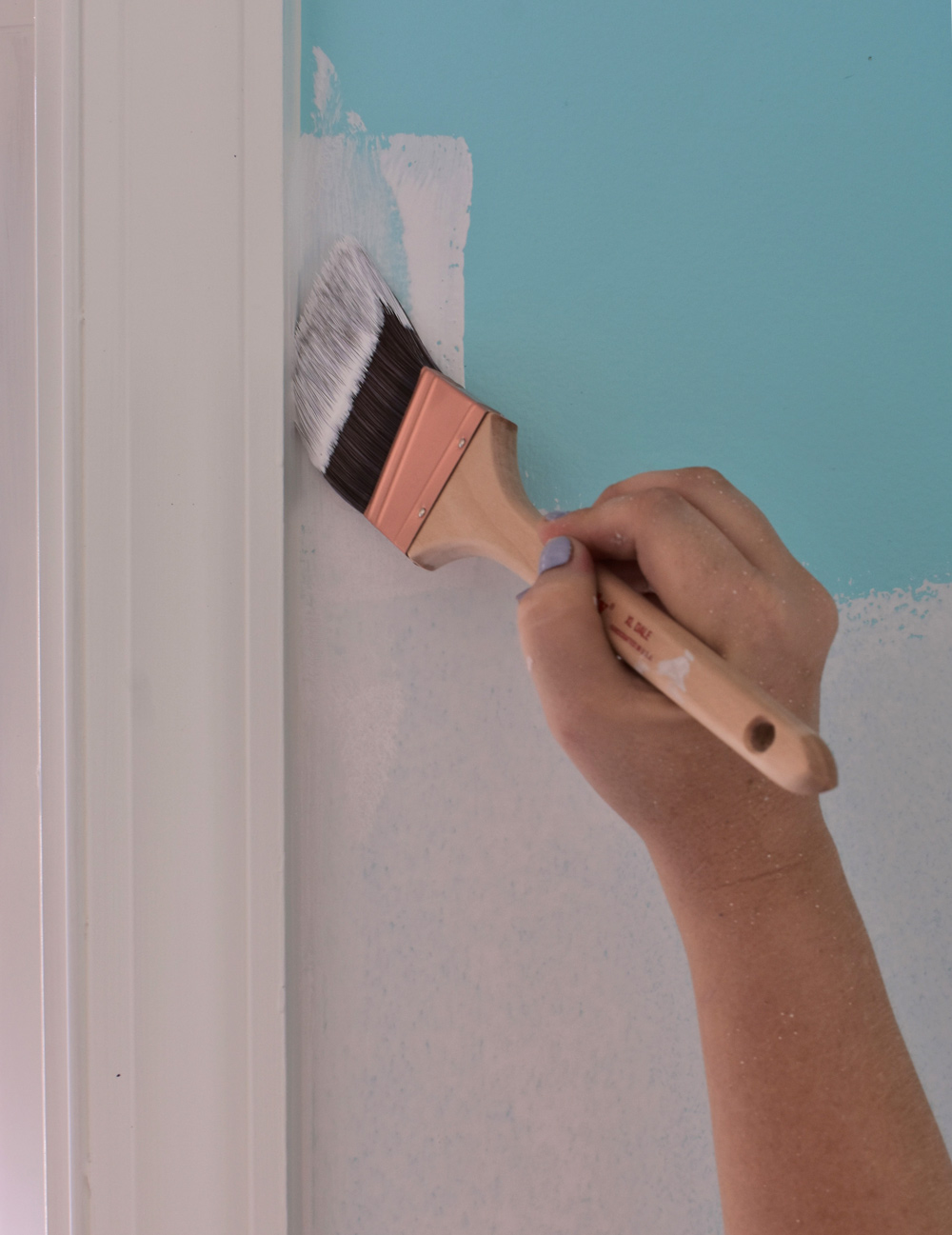
Kids’ rooms always seem to have a layer of gunk and grime, so a good wipe down of the walls is first on the list. Now, we were set to cover up years of scuff marks, stains, and “artwork”. After scraping stickers, filling holes in the wall, and removing screws and nails, we scraped off loose paint and lightly sanded it for a smooth finish. For the application, a high-quality nylon/polyester roller with a 3/8-1/2″ nap is recommended on smooth surfaces, like Saegan’s. If you are prepping a semi-rough or porous surface, you will want to go with a 1/2-3/4″ nap.
After an even primer application, we were left with a bright, clean surface that served as the perfect blank slate to begin. And best of all, it was dry to the touch in only 30 minutes, and we were ready to begin applying our new colors in an hour!
The break in the dormer walls was the perfect guide for where to separate our two colors. Using painter’s tape and a steady hand, we applied our soft color palette to the primed walls. After the addition of plenty of blush tone furniture and fabrics and gold accents, Saegan’s room transformed. Prepping the walls to ensure a beautiful finish, the two paint colors provided the perfect foundation to bring her lighter and brighter blush tween room to life.
*This is a paid partnership with Angela Cacace.
Always remember to refer to our website kilz.com or product back labels for additional information on which primer is right for your project and detailed instructions on how to apply our products.
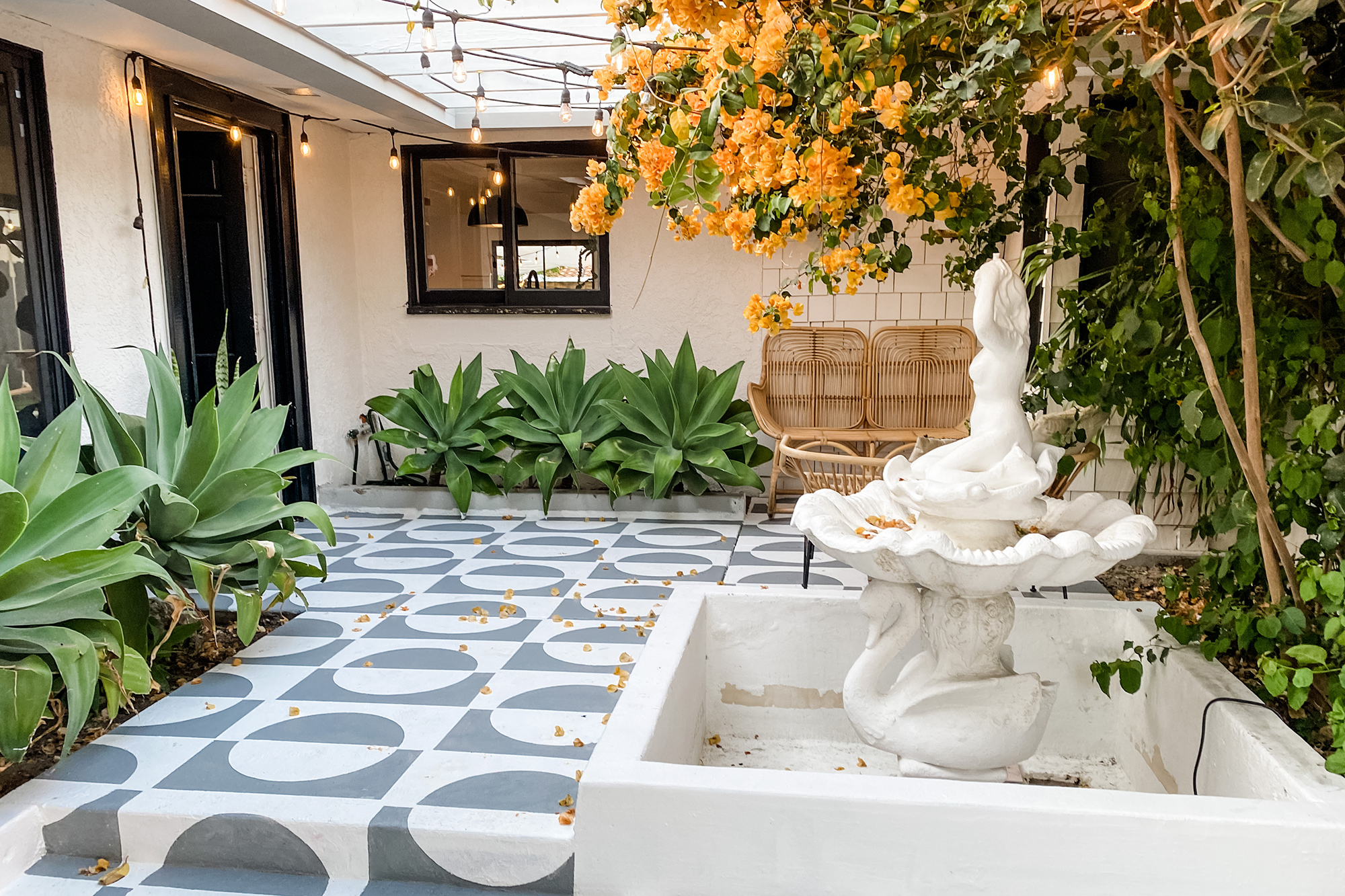
Pro Spotlight: Jesi Haack’s Mid-Century Courtyard Makeover
September 20, 2021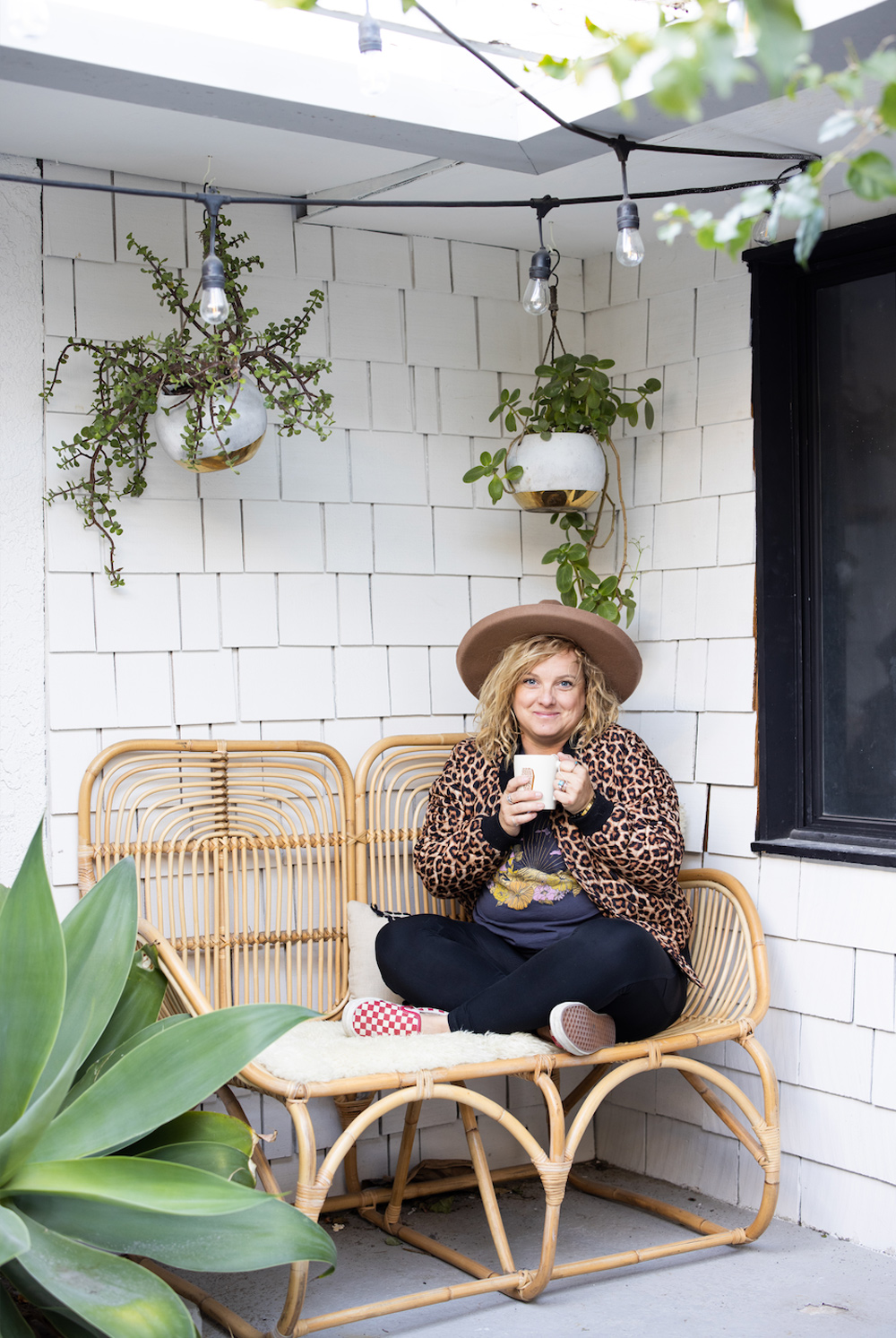 This month on The Perfect Finish, we have an inspiring Q&A to share that includes a stunning stenciled courtyard makeover. A friend of the KILZ team, Jesi Haack is a talented event designer with some serious interior design skills as well. Jesi’s full-service event design company, Jesi Haack Design, transforms traditional events into trendy affairs. She is also the Co-Founder of SLAACK Productions, a corporate event production company specializing in creative & interactive design experiences & installations.
This month on The Perfect Finish, we have an inspiring Q&A to share that includes a stunning stenciled courtyard makeover. A friend of the KILZ team, Jesi Haack is a talented event designer with some serious interior design skills as well. Jesi’s full-service event design company, Jesi Haack Design, transforms traditional events into trendy affairs. She is also the Co-Founder of SLAACK Productions, a corporate event production company specializing in creative & interactive design experiences & installations.
Jesi recently completed a jaw-dropping makeover of her home’s front courtyard, and it inspires some serious DIY envy. Read on to learn more about Jesi and how she completed this gorgeous transformation.
Before we talk about your stunning patio project, we’d love to delve into your DIY/designer background. You own an event design and production agency, and on top of that you’re a super talented DIY-er and interior designer. Tell us how you first got into interior design and DIY’ing and how that led to where you are now.
Well, I’ve always loved making things look cool. Whether it’s for events or in my home. So once Covid hit and turned the lights out on our busy production company, I suddenly had a ton of time on my hands and no creative outlet. Pair that with buying our first fixer home and a huge income hit, I became a DIY’er! Hahaha! I just started figuring stuff out on my own because of boredom, lack of funds and a need for creativity. Once I started sharing my projects on social media, I didn’t anticipate so many people would like what I was doing! And then they started asking me to help with their homes, offices, and projects! It’s been a blast!
Where do you find inspiration for your DIY home improvement projects? Has work for your event design business inspired any of your interior design projects?
I’m inspired by so many different outlets and people. I follow a bunch of different types of builders and creators (I think of them as more than DIY’ers because it truly is an art what they do) and other people’s work is truly an inspiration. And yes! My event installation background is a huge aspect to my work and my style. I try to think outside the normal interior design box and bring in more three-dimensional aspects to interiors. More like art installations that make a big impact. At least that’s where my thought process is.
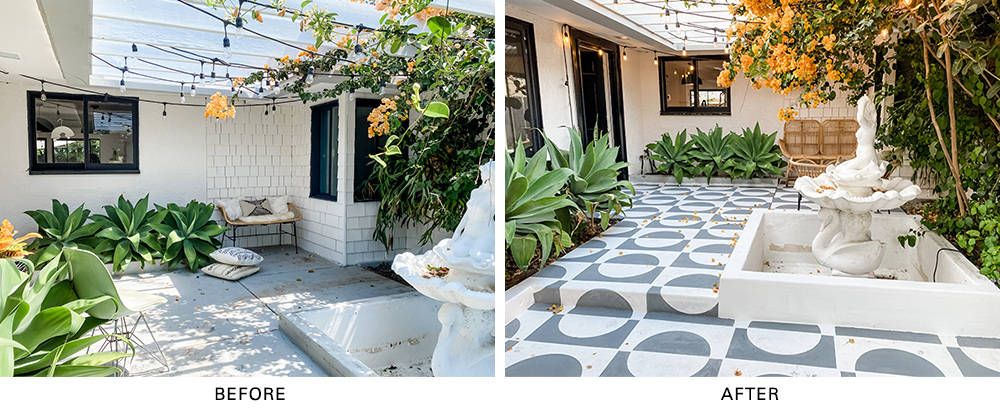
Let’s talk about your recent patio project. What inspired the design and what was the overall process?
I’ve spent a ton of time in Palm Springs for work and am so inspired by the architecture there and the mid-century design style. Our patio was so basic and the concrete so ugly, I knew I wanted to bring it alive with a pattern. I also knew it was an area I didn’t want to play it safe with. I wanted it to make people stop for a sec and notice before entering our home! It was a pretty simple process: clean – prime – stencil – seal!
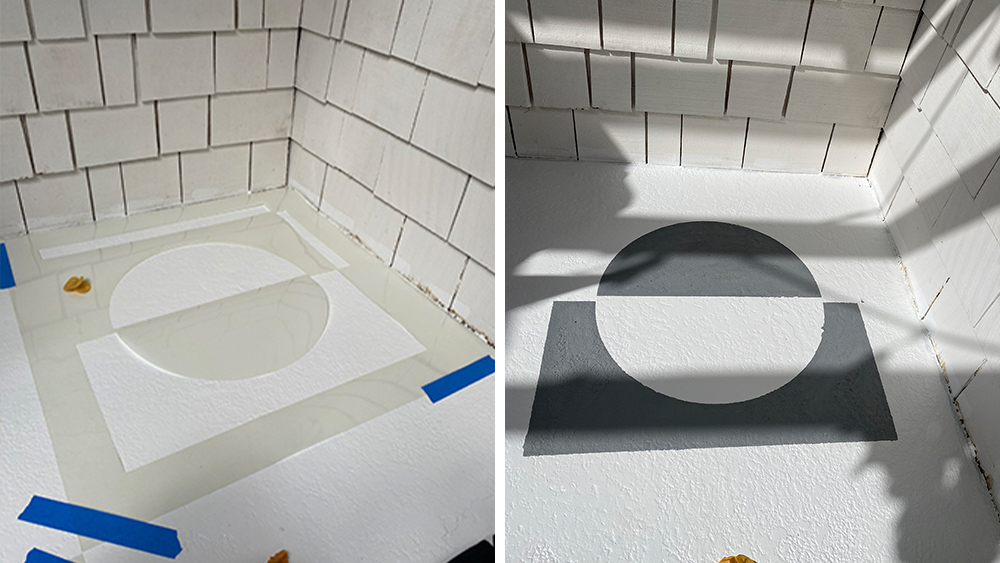
Which KILZ product did you use for the patio makeover and why? How do you think it impacted the project?
I used KILZ 3® Premium Primer and KILZ Over Armor® concrete coating. Kilz primers are my literal go to for any project because they seal the surface I’m working on. For this one in particular, a quality primer was clutch for covering up chipped paint and giving me a blank canvas to use for my stencils.
How did you first learn about KILZ? Have you used KILZ primers for any other projects?
I think my dad told me about Kilz long ago when I started creating. I’ve literally used the primer on everything! My baseboards which got rid of water stains and still have kept them away! Lots of painting projects for our events, the primer helps keep our wood sets from warping in outdoor settings.
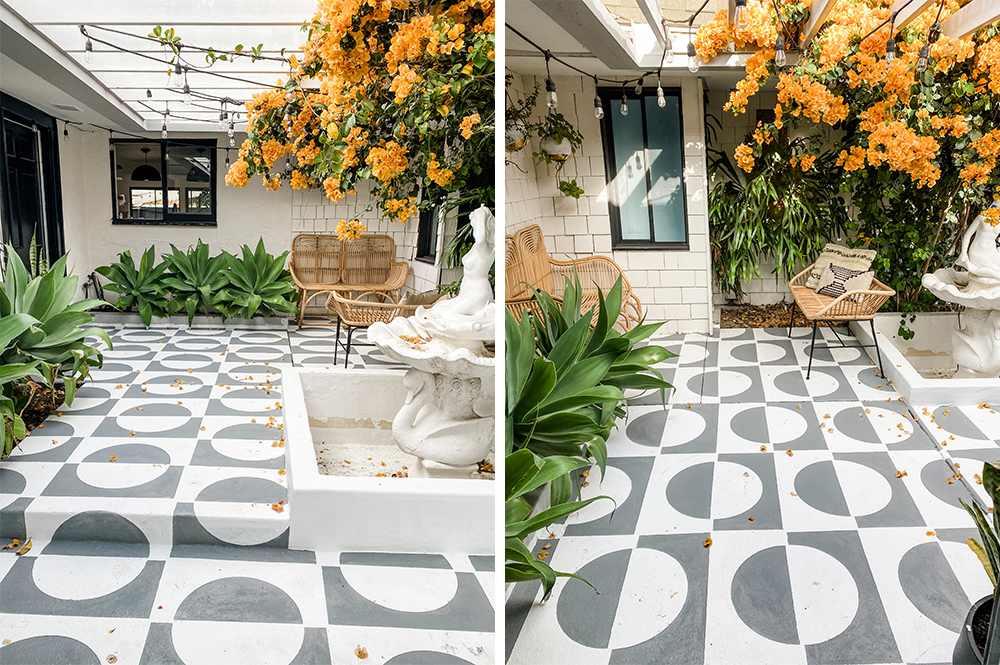
When completing any DIY or interior design project, what are your tips and tricks for success?
A tough lesson I have learned is don’t rush! This is so hard for me. I love diving in and getting to the end result. But don’t skip prepping! Properly taping off and using primer will make your project look more legit in the end and will save you touch up work when all is said and done!
Jesi Haack’s Step-by-Step Directions for a Mid-Century Courtyard Makeover
1. Power wash cement.
2. Use a cement cleaner and pour it on with a plastic watering bucket. Don’t use metal! Scrub with a stiff bristle brush.
3. Let dry completely, typically a day or two.
4. Prime! Use a roller to get a smooth layer. I did 3 coats because I was using Kilz primer as my base coat. Wait a few hours between coats.
5. Map out your pattern with chalk line. (I skipped this step and I regret it). This will ensure each time placement lines up and is straight. Make squares that are the size of your stencil.
6. Time to stencil! Lay stencil down on each square. Use an angled brush to paint on cement paint. I had two stencils so I would alternate so it would give the paint on the stencil a bit of time to dry so it wouldn’t transfer the paint that got on the stencil to the new square. Wash off your stencil every so often to keep your lines nice and clean. Don’t stress too much about lines, you can touch up at the end!
7. Touch up messy lines and spot clean where needed.
8. Let cure for 72 hours.
9. Paint on a cement sealer! Wait 24 hours before using!
Always remember to refer to our website kilz.com or product back labels for additional information on which primer is right for your project and detailed instructions on how to apply our products.
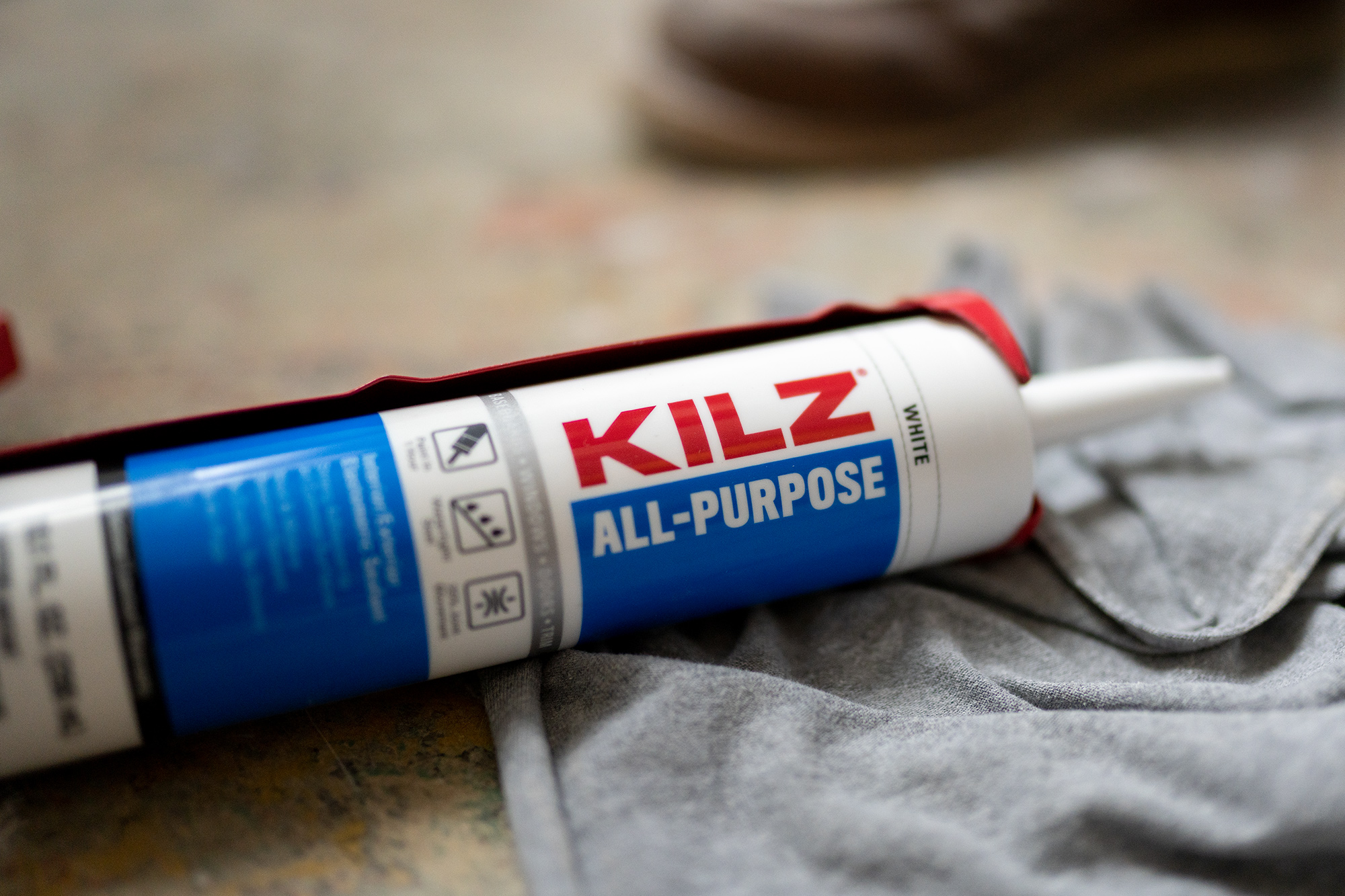
Ask the Pro: Caulks & Sealants 101
September 20, 2021 We talk a lot about primer here on The Perfect Finish, but today we’re excited to dive into a different home renovation product – caulks & sealants! KILZ recently launched a line of caulks & sealants, created for a variety of interior and exterior projects. To share more about these new products and offer tips and best practices for using caulks and sealants in a variety of DIY projects, we tapped Chuck Eisenhauer.
We talk a lot about primer here on The Perfect Finish, but today we’re excited to dive into a different home renovation product – caulks & sealants! KILZ recently launched a line of caulks & sealants, created for a variety of interior and exterior projects. To share more about these new products and offer tips and best practices for using caulks and sealants in a variety of DIY projects, we tapped Chuck Eisenhauer.
A Product Manager on the KILZ team for over three years with a background in Chemical Engineering, Chuck is an expert on all things caulks and sealants. Whether you’re trying to figure out which KILZ product is right for you, or where and how to use them once you’ve bought them – Chuck’s got your answer!
Let’s start with the basics, what is caulk?
“Caulk” or (less frequently) “caulking” is a material used to seal joints or seams against leakage in various structures and piping. The oldest form of caulk consisted of fibrous materials driven into the wedge-shaped seams between boards on wooden boats or ships.
What is the difference between caulks and sealants?
Most often these two terms are used interchangeably, and the two products serve the same purpose: to fill gaps between materials and to keep water and air EITHER in or out. For us, the main difference between a caulk and a sealant is elasticity. Caulks are fairly rigid when dry and are intended for use in areas with minimal expansion and contraction. Sealants are made from flexible material making them ideal for areas prone to more significant expansion and contraction.
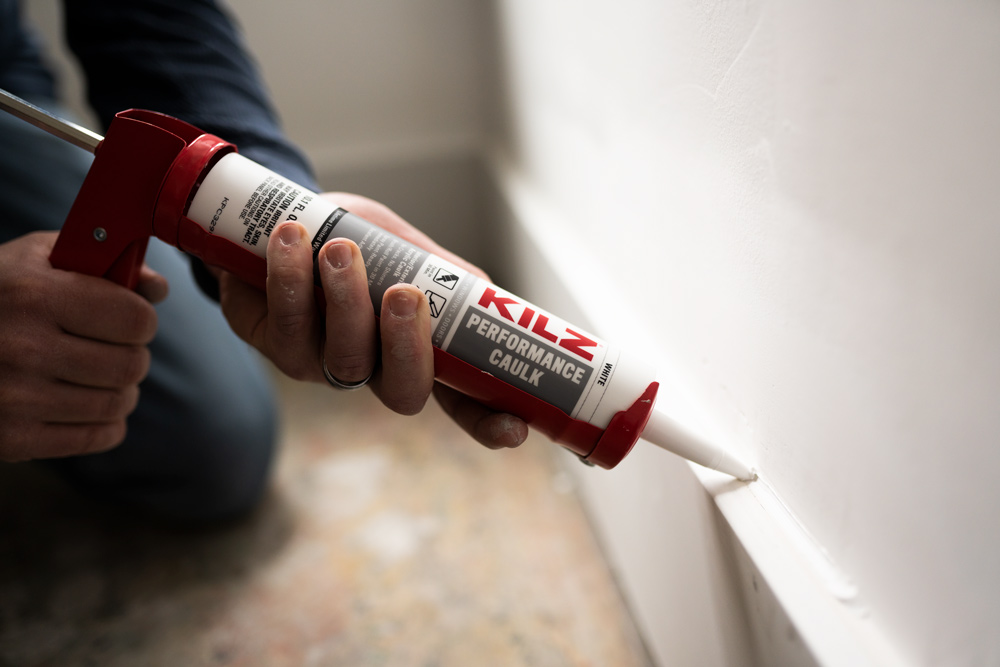
What types of projects typically require a caulking or sealing product?
Any project you need to seal a joint or seam! Typically, you will see caulks or sealants most often used in projects where someone is needing to replace old caulking or is sealing new joints/cracks/etc. before priming and painting. Most of our products are best used for sealing cracks, filling openings like nail holes, or sealing connection joints between stairs, walls, skirting boards, ceilings, windowsills, etc. Customers should refer to the back of the product label or the product Technical Data Sheet for information on what surfaces and situations our products can/cannot be used for.
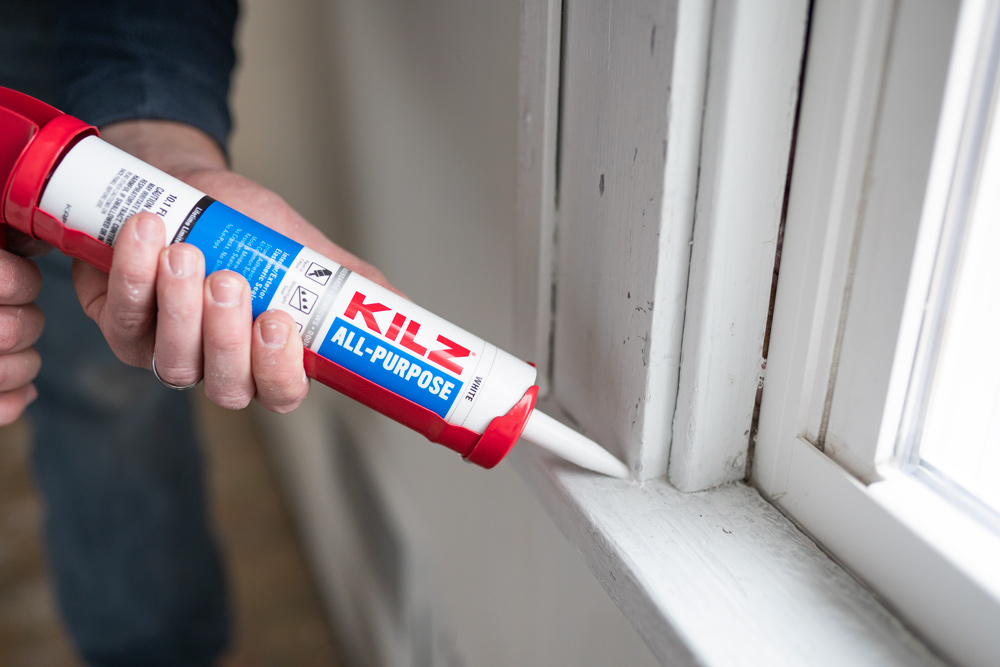
Are caulks and sealants products always white, or do they come in other colors?
Colors will vary from product to product, and brand to brand. Here at KILZ, we have two products that have multiple colors: our Waterproof Sealant and our Premium Seal. Our Waterproof Sealant, an interior 100% silicone, is available in both clear and white – perfect for use in kitchens or bathrooms. Our interior/exterior Premium Seal sealant is available in both white and black.
Can you paint over a caulked surface once dry, or should you use a primer first?
At KILZ we understand the value of using a primer in your painting projects and will always recommend using one of our KILZ® branded primers prior to painting. However, in situations where a primer is not available or not preferred, our caulks and sealants can be painted over directly once they are dry. Each product has a different dry time that is indicated on the label to let you know how long you should wait before priming or painting. When applying our KILZ line of caulks and sealants outside, the dried product should always be primed and painted over for best results.
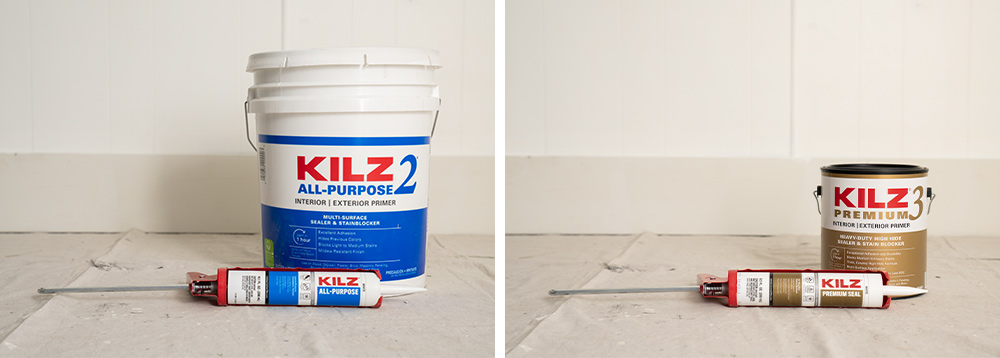
What are the key benefits of using a fast-drying caulk?
The biggest benefit is that you’ll be done with your project much sooner! Our KILZ Quick Dry caulk can be painted with a paint sprayer immediately after application, and only requires a 10-minute dry time before it can be painted with a brush or roller. Compared to 30-minutes or even hours of dry time required by other products in the market, you have an opportunity to save a significant amount of time on your project by using our KILZ Quick Dry fast-drying caulk.
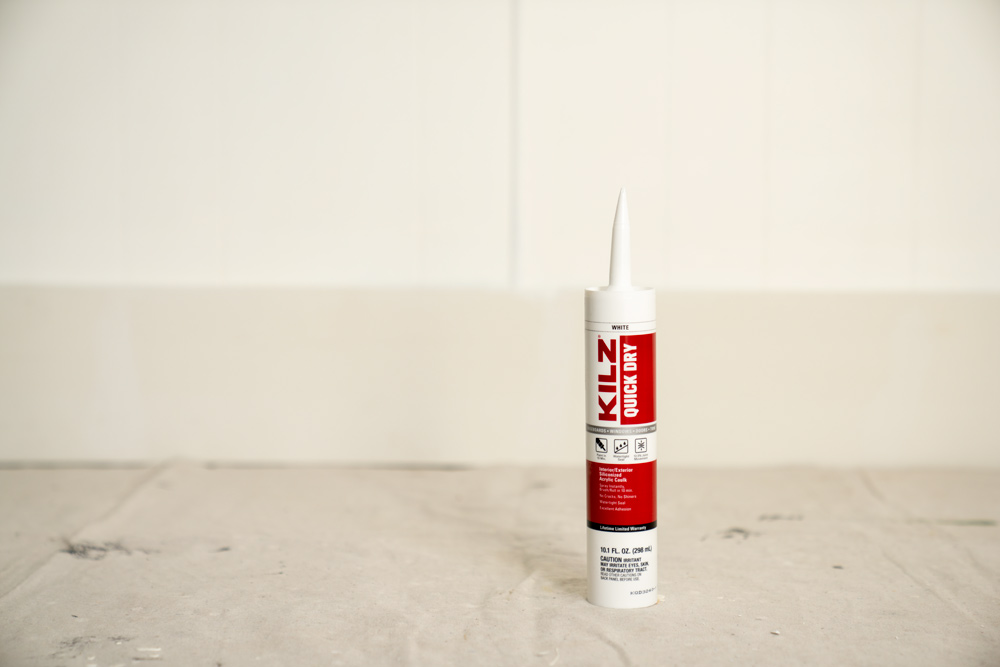
Are there different caulk and sealant products for indoor and outdoor use?
There are! Most (but not all) of our products can be used both inside and outdoors, but some perform better in one or the other. For example, our KILZ Performance Caulk performs best indoor whereas our KILZ Premium Seal is best used for outdoor projects. When using any of our interior/exterior products outdoors, it’s important that they be painted over to achieve the best results. The only product that is specifically stated for indoor use only is our KILZ Waterproof Sealant – this product was not designed or intended to be used outside.
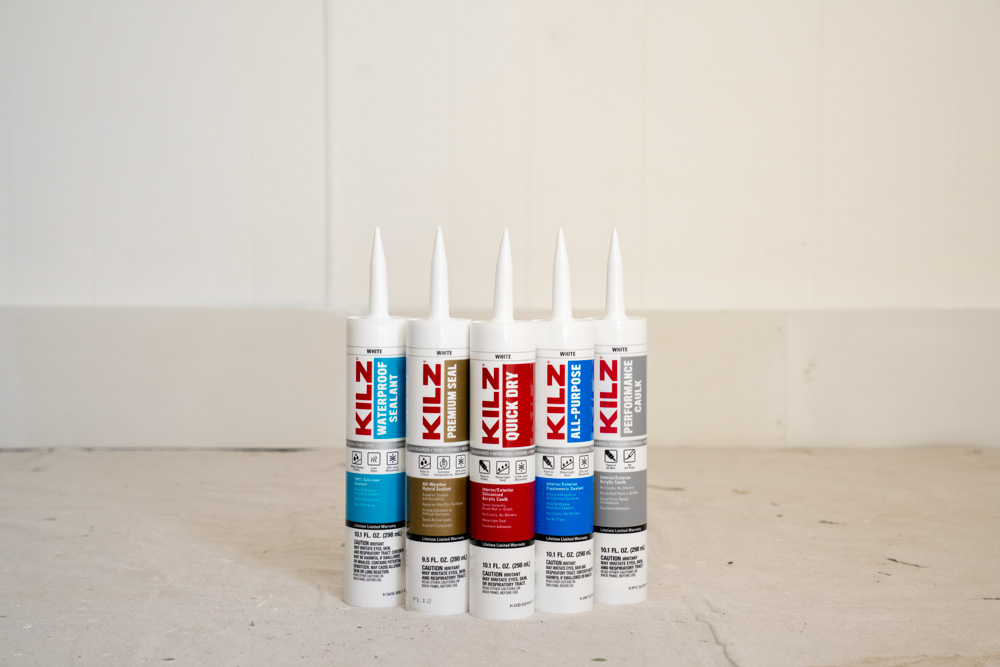
KILZ new line of caulks and sealants includes five new products, can you walk us through each and what types of projects they are formulated for?
• Our KILZ Performance Caulk is a high-quality interior and exterior acrylic caulk that prevents cracking when it’s dry and is easily applied with consistent flow (meaning no air-pops during application). This product is brush/roll paintable in 30-minutes, compatible with all oil and water-based paints, and can be painted using a paint sprayer immediately. This product is great for sealing joints between places like stairs, ceilings, and windowsills, and can be used to fill in cracks and nail holes.
• Our KILZ Quick Dry Caulk is a fast-drying, high-quality interior and exterior acrylic caulk that prevents cracking when dried and is easily applied with consistent flow during application. This unique formula creates a watertight seal and provides excellent adhesion to most common surfaces. This product is instantly paintable with a paint sprayer and can be brush/roll painted in 10-minutes! Similar to KILZ Performance Caulk, it is formulated for sealing joints and filling cracks or holes.
• Our KILZ All-Purpose Sealant is a premium siliconized acrylic latex with excellent adhesion and weatherability for both interior and exterior use. This easy to apply formula offers outstanding weather durability, has strong adhesion to all common surfaces, and has a high elasticity for flexible joints without cracking or breaking the adhesion bond. This product includes a EPA-registered mildewcide that prevents mold and mildew from forming in the sealant film, and is compatible with all water and oil-based paints. It can be used to seal common surfaces including windows and door frames, baseboards, sinks, tubs, countertops, ceramic tile and other common household projects and surfaces.
• Our KILZ Premium Seal is a non-yellowing, high performance silicone-hybrid sealant built to offer superior stretch and durability on the most difficult surfaces. Built to withstand extreme temperatures, this formula can be applied in both wet and dry conditions, is UV-resistant, is asphalt compatible, and can seal active leaks up to 1/4″ in size. Primary applications include expansion and control joints, sealing roofing and flashing applications, and masonry joints. You can also use this product to seal vinyl windows, door frames and sidings, and other metal building construction and synthetic materials.
• Our KILZ Waterproof Sealant is a versatile, low-odor, mold and has a mildew-resistant 100% Silicone sealant film offering permanent flexibility in a finished seal that will not crack or shrink. Ideal for interior areas that are prone to water exposure, this high-performing durable formula creates a 100% waterproof finish that is water-ready in 10 minutes. It is formulated for use on interior surfaces commonly found in kitchens and bathrooms including metal, wood, glass, drywall, granite, cultured marble, ceramic and porcelain tile and natural stone.
What other tools might you need when using a caulk or sealant?
First thing’s first: you’re going to need a caulking gun. Depending on the type of caulking gun used, you might need to have a safety razor or scissors to cut the plastic tip off the cartridge. For some products, like our Premium Seal and Waterproof Sealant, you’ll need to puncture a foil cap inside the tip. Next, you might want to smooth out or tool the final look of your caulked product by either using a caulking tool or a glove-covered finger. Finally, depending on which product you have, it will be helpful to have a clean rag and some soapy water, or solvent/baby wipes available close by for clean-up.
Always remember to refer to our website kilz.com or product back labels for additional information on which primer is right for your project and detailed instructions on how to apply our products.
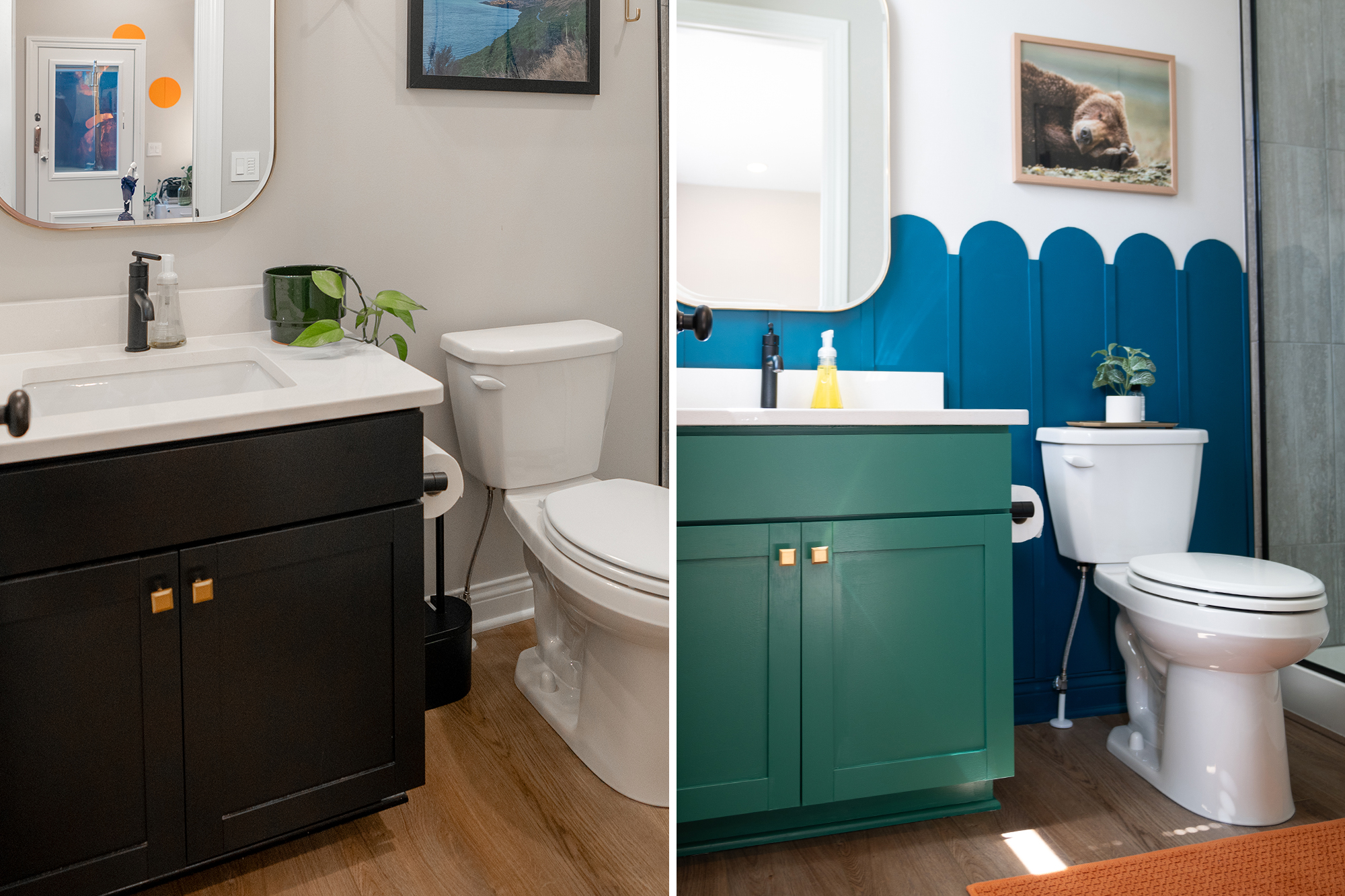
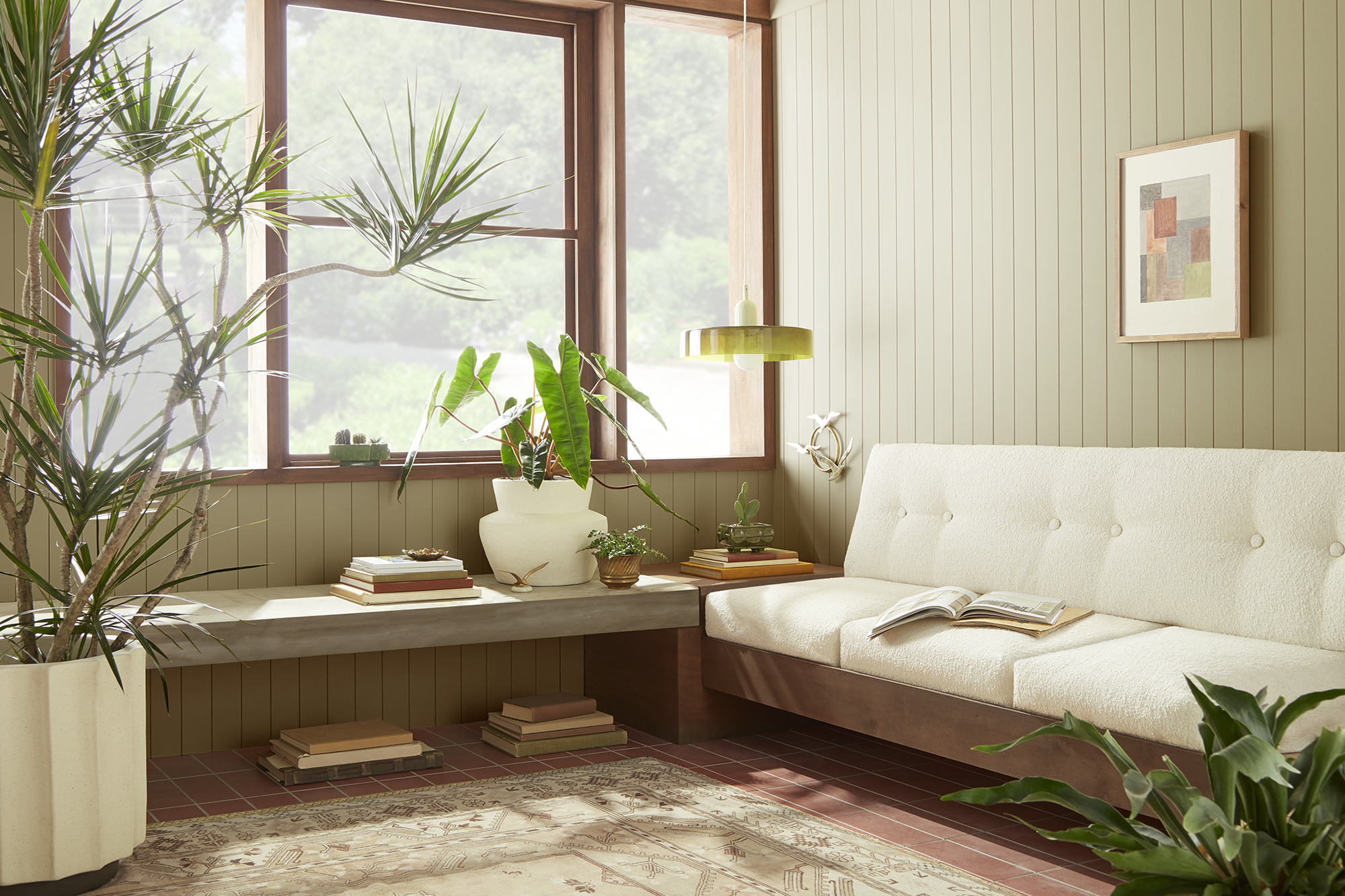

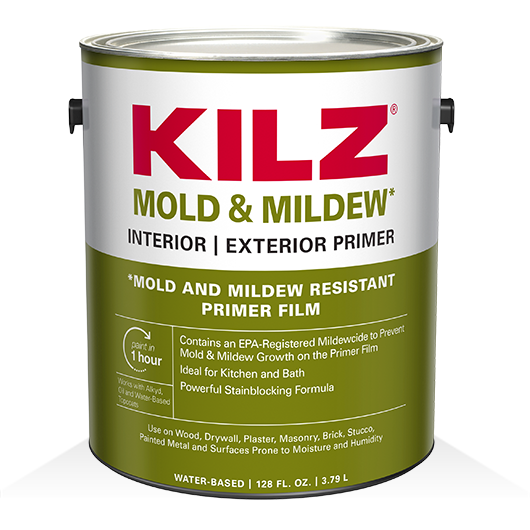
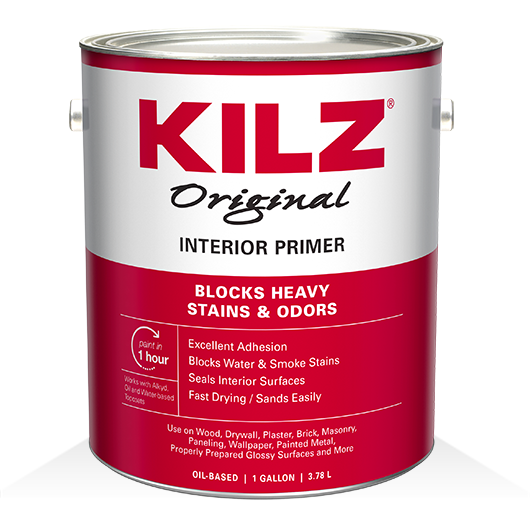
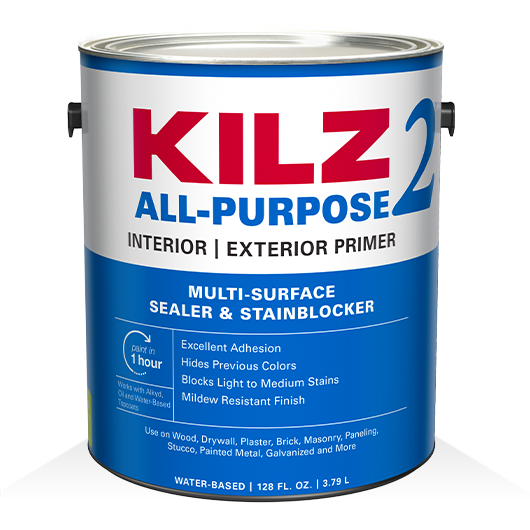
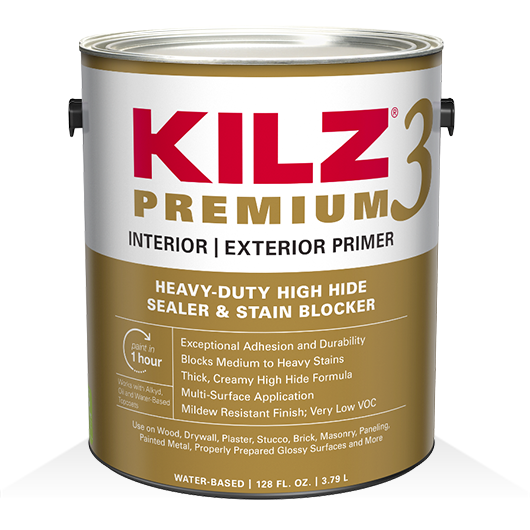
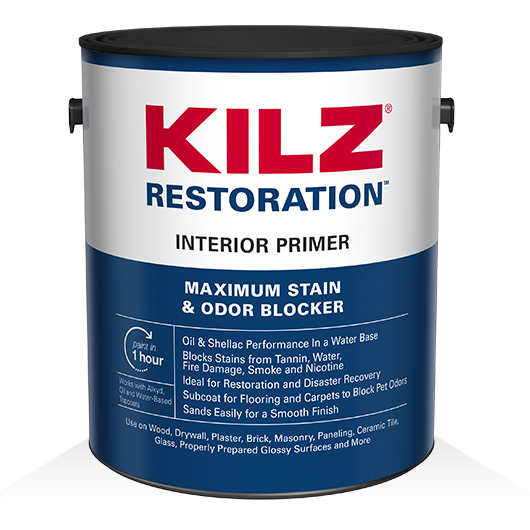
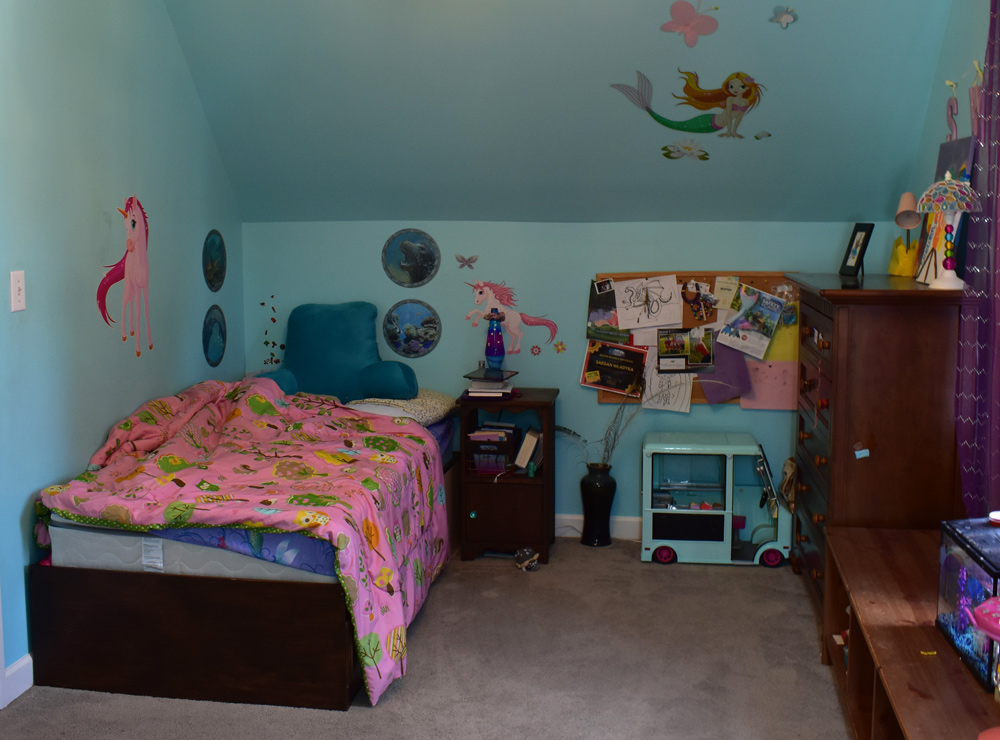
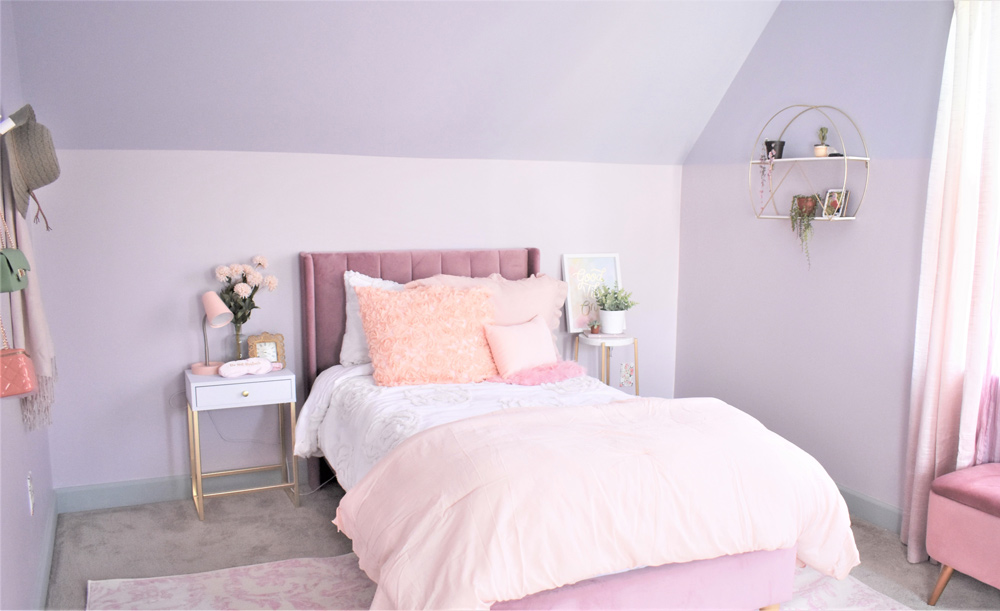
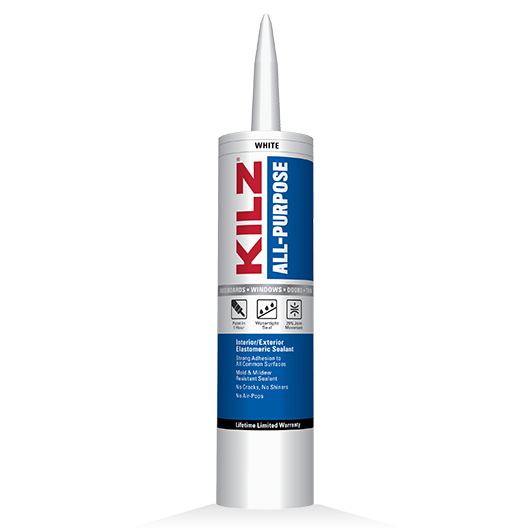
join the conversation:
SHARE this post: